 |
PO Box 9021,
Wilmington, DE 19809, USA
E-mail: font@focusonnature.com
Phone: Toll-free in USA 1-888-721-3555
or 302/529-1876 |
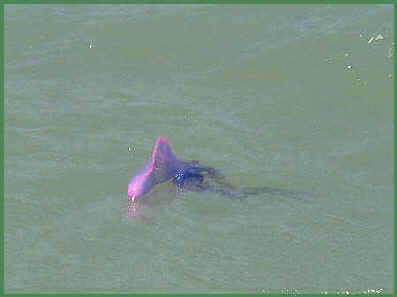 MARINE LIFE
MARINE LIFE
of Eastern North America
of and by the Atlantic Ocean
other than Whales, Dolphins,
Seals
and the Manatee
including inshore and offshore waters
of coastal North Carolina
and
those of the Delmarva Peninsula
A list compiled by Armas Hill
There are 764 species of various marine
creatures in this list.
With those seen during Focus On Nature tours and pelagic trips
with an (*)
Photo at upper
right: the jellyfish known as the PORTUGUESE MAN-OF-WAR
Links, in the following list, to:
Sea
Turtles
Fish
Sponges
CNIDARIANS: Corals
Sea Anemones
Jellyfish
Hydroids
Comb Jellies
Mollusks
(including Shells):
CHITONS
GASTROPODS Limpets
Periwinkles Sundials
Wendletraps Cowries
Moon Shells & Naticas
Helmet Shells Tritons
Rock Shells & Dogwinkles
Dove Shells
Whelks Tulip Shells
Olive Shells Nutmegs
Cone Shells
Auger Shells
Turret Shells Pyramid
Shells Bubble Shells
Tusk Shells
TUSK SHELLS (above)
are not GASTROPODS but SCAPHOPODS.
The groups in the following line are GASTROPODS, but some are without shells.
Sea Butterflies Sea Hares
Nudibranchs & allies
BIVALVES:
Mussels Pearl Oyster
Pen
Shells Scallops File Shells
Jingle Shells
Oysters
Clams (including Cockles) Lucines Tellins
Bean Clams Razor Clams
Surf Clams Rock Borers
Corbula Clams Piddocks
Shipworms Lysonias
Pandoras
Spoon Clams
Dipper Shells
CEPHALOPODS:
Squids Octopuses
Paper
Argonauts
Arthropods (including
Horseshoe Crab): Sea
Spiders
CRUSTACEANS
Barnacles
(and Isopods, Amphipods, Beach Fleas) Shrimps, Lobsters Crabs
Included with SHRIMP (above)
is KRILL, the food of baleen whales.
Echinoderms
Sea Stars, Asteroids Sea
Urchins, Sand Dollar, Sea Biscuit Sea Cucumbers
Chordates: Sea Squirts & Tunicates
Lancelet Brachiopods
Bryozoans (plant-like animals)
Other Links:
Marine Life of
Iceland Marine Life of Southeast US, including the Gulf Coast
from Florida to Texas
Marine Life of the West Indies
Marine Life in Western North
America, from Alaska to Mexico
Marine Life of eastern Mexico, Belize, & Honduras
Mammals of Eastern North America, including Marine Mammals: Whales, Dolphins,
Seals, Manatee
A Listing of scheduled Focus On Nature Tours in the places in the above links
Upcoming
Focus On Nature Tours in North America FONT
Past Tour Highlights

Codes:
For all of the following
either along the coast or offshore
DE
in Delaware
FL in Florida
NC in
North Carolina
NJ
in
New Jersey
NF in
Newfoundland, Canada
(p)
pelagically
(ASC:xx) refers to the plate number of a photo in the "National
Audubon Society Field Guide to Seashore Creatures"
(AS:xx) refers to the plate number of a
photo in the "National Audubon Society Field Guide to North American
Seashells"
(FGCF:xx) refers to the page with an
illustration in the book "A Field Guide to Coastal Fishes, from Maine to Texas", by
Val Kells & Kent Carpenter, 2011.
(PAS:xx) refers to the plate with an
illustration in the "Peterson Field Guide, Atlantic Seashore", by
Kenneth Gosner, 1978.
(PS:xx) refers to plate number with an
illustration in the "Peterson Field Guide, Shells of the Atlantic and
Gulf Coasts and the West Indies", by R. Tucker Abbott and Perry Morris,
1995
These classifications by the ICUN (International Union for Conservation of
Nature)
of Threatened & Near-threatened species;
(t1): critically endangered
(t2): endangered
(t3); vulnerable
(nt): near-threatened
(ph): species with a photo in the FONT website
A very good and interesting book, that is
a informational source for some of what follows in this list, is the "Nature
Guide to the Carolina Coast", by Peter Meyer, 1991 and
later.
Another good and informative book is "Beachcomber's Guide from Cape
Cod to Cape Hatteras", by Henry Keatts, 1985.
Some of the information incorporated into this list is from that book, as
well as those noted below.
Some fine books, both interesting and gain informative, about various groupings
of marine creatures in this list are the following:
"Voyage of the Turtle - in Pursuit of the Earth's Last Dinosaurs",
by Carl Safina, 2007
"The Search for the Giant Squid, the Biology and Mythology of the
World's Most Elusive Sea Creature", by Richard Ellis, 1999
(not just referring to the Giant Squids but also other squids)
"Octopus! the Most Mysterious Creature in the Sea", by Katherine
Harmon Courage, 2013
"Walking Sideways - the Remarkable World of Crabs", by Judith Weis,
2012
MARINE, or SEA, TURTLES
(Reptiles)
- Leatherback (Sea) Turtle (t1) (ph) (*)
______ DE(p) NC(p) NJ(p)
Dermochelys coriacea
The Leatherback Sea Turtle is the world's largest turtle. It can weigh half a
ton. It is a deep
diver, able to go to a depth of about 5,000 feet.
- Loggerhead (Sea) Turtle (t2) (ph) (*)
______ DE(p) NC(p) NJ(p)
Caretta caretta
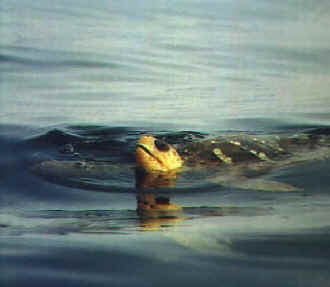
A Loggerhead Sea Turtle photographed during a
FONT pelagic trip
(photo by Alan Brady)
- Kemp's Ridley (Sea) Turtle (t1) (*)
______ DE(p)
Lepidochelys kempii
The Kemp's Ridley Turtle is the world's rarest sea turtle. It is classified as
"critically endangered".
- Green (Sea) Turtle (t2) (ph)
______ DE
Chelonia mydas
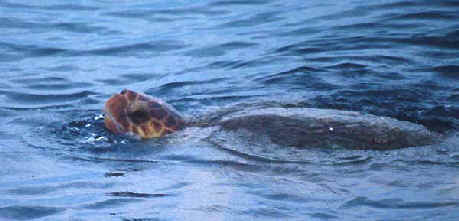
A Green Sea Turtle photographed during a FONT tour
Again, as previously noted, an excellent book about sea turtles is "Voyage
of the Turtle - in Pursuit of the Earth's Last Dinosaurs", by Carl
Safina, Owl Books, 2007.
FISH
Click the above link to a list of
marine fish of
eastern North America: 560 species
- Sharks' Teeth ______ NC
Occasionally, one who is beachcombing on a sandy beach is fortunate to
find what appears to be, and in fact is a tooth, dark in color, and from
one-half to several inches in length. Such a find is likely to be a sharks'
tooth.
On beaches in North and South Carolina, the teeth of about 14 species are to
found, among them those of: Great White, Hammerhead, Tiger, Bull, and
Lemon Sharks.
Such teeth are not from sharks currently alive. They are fossil
teeth, from sharks that lived thousands to millions of years ago. Dark
teeth found on the beach are all fossils. A tooth from a present-day shark
is white, and rarely found on the beach.
Actually, sharks' teeth are about the only remnants from ancient
sharks. Unlike most fish whose skeletons are composed of hard bone,
those of sharks are composed of softer
cartilage.
The hardest substance in the bodies of sharks are their teeth.
When they die, their bodies decompose, except for their teeth, which can
continue to exist for eons.
Sharks produce a large number of teeth during their lives. It
is estimated that a Tiger Shark, for example, produces up to 24,000 teeth
in a 10-year period.
INVERTEBRATES
including those of the OPEN OCEAN:
SPONGES (Phylum
Porifera)
Class CALCISPONGIAE:
the CALCAREA
with limy spicules
-
Organ-pipe Sponges ______ (ASC:54)
(PAS:10)
the Gulf of St. Lawrence to Cape Cod
Leucosolenia botryoides
- Little Vase Sponge ______ (ASC:45)
from the Arctic to Rhode Island, also North American Pacific coast
Scypha coliata
Class
DEMOSPONGIAE
- Dujardin's Slime Sponge ______
(ASC:115) from the Arctic to Cape Cod MA
Halisarca dujardini
- Loosanoff's Haliclona ______
DE MD (PAS:10) Cape Cod to the Chesapeake Bay, possibly
south to Cape Hatteras
Haliclona loosanoffi
- Finger Sponge ______
(ASC:520 (PAS:11) Labrador to Long Island, NY, rarely south to
North Carolina
Haliclona oculata
Haliclona oculata
is called the "Eyed Sponge" because its pores resemble many
eyes. It is often broken free by storms and washed up on the beach, where
its skeleton bleaches to white.
- Purple Sponge ______ VA
(ASC:126) (PAS:11)
in Maine, and the lower Chesapeake Bay where it is abundant; also the North
American Pacific coast
Haliclona permollis
The Purple Sponge is encrusted on rocks in protected places, and
on floating docks and in tidepools, from the midtidal zone to water up to 20
feet deep.
- Common Palmate Sponge ______ DE
MD NC VA (ASC:28)
Nova Scotia, Canada to North Carolina
Isodictya
palmata
In the British Isles, where Isodictya
palmata also occurs, it is known as "Mermaid's
Gloves".
- Egg Sponge ______
(PAS:10) from the Arctic south to New Hampshire
Mycalecarmia ovulum
- Bowerbank's Crumb of Bread Sponge ______
(PAS:10) Bay of Fundy to Cape Cod, also North
American Pacific coast
Halichondria bowerbanki
Another name for Halichondria bowerbanki
is Bowerbank's Halichondria. It can be distinguished from the
following species, Halichondria panicea,
only by its spicules.
- Crumb of Bread
Sponge
______ (ASC:123) (PAS:10) from the
Arctic to Cape Cod, also North American Pacific coast
Halichondria panicea
Other names for Halichondria panicea
are Crumb Sponge or Bread Sponge.
- Red Beard Sponge ______ DE
FL MD NC VA (ASC:29)
(PAS:11)
along the entire Atlantic coast of North America; also North American
Pacific coast
Microciona prolifera
The Red Beard Sponge tolerates both the pollution and the reduced
salinities of bays and estuaries.
- Nipple Sponge ______ (ASC:53)
Gulf of St. Lawrence to Cope Cod MA
Polymastia robusta
- Loggerhead Sponge ______ FL
NC (ASC:17) North
Carolina to Florida and Mexico, also West Indies
Spheciospongia
vesparia
Spheciospongia vesparia is the
largest sponge known, up to 36 inches wide and 24 inches high.
As many as 16,000 animals, most of them snapping shrimp, have been recorded
living in the canal system of one specimen.
Spheciospongia vesparia shares
the same common name (Loggerhead Sponge) as an unrelated sponge, Ircinia
strobilina that occurs in the warm waters of the Caribbean Sea and the Gulf
of Mexico.
- Fig Sponge ______
(PAS:11) from the Arctic south to Rhode Island,
possibly Virginia
Suberites ficus
Boring Sponges (PAS:10):
- Cliona celata
______ DE FL MD NC VA
(ASC:127) Long Island, NY to the Gulf of Mexico, also North
American Pacific coast
- Cliona truitti
______ locally north to the Bay of Fundy
- Cliona vastifica
______ locally north to the Gulf of St. Lawrence
A third class of sponges, HYALOSPONGIAE, the
GLASS SPONGES, occurs only in deep waters further offshore.
The grouping is also known as HEXACTINELLIDA.
CNIDARIANS (including corals
and jellyfish)
STONY CORALS (Class Anthozoa, order Scleractinia)
- Northern Stony Coral ______ FL
NC
(PAS:20) Cape Cod to Florida, also West Indies
Astrangia danae
Astrangia danae
is sometimes washed ashore.
- Oculina sp. ______ FL
NC
Oculina
is washed ashore from Cape Hatteras, NC to the West Indies.
OCTOCORALS
(Class Anthozoa, subclass Octocorallia)
- Red Soft Coral ______
(ASC:37,39) from the Arctic to the Gulf of Maine,
also North American Pacific coast
Gersemia rubiformis
- Dead Man's Fingers ______
(PAS:10)
Gulf of St. Lawrence to Rhode Island
Alcyonium digitatum
- Sea Whip (ph)
______
FL MD NC VA
(ASC:63) (PAS:11)
New Jersey to the Gulf of
Mexico
Leptogorgia virgulata
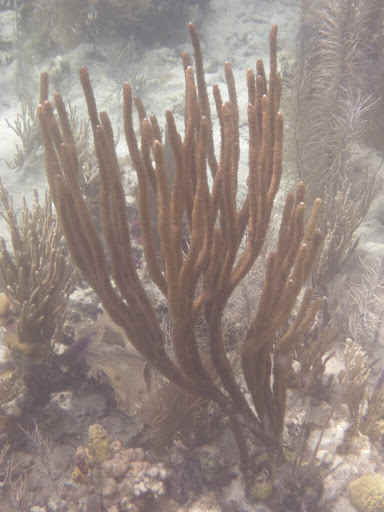
Sea Whip
(photo courtesy of Diane Allison)
- Straight Sea Whip ______
MD VA ranges into the Chesapeake Bay as far
north as the Patuxent River
Leptogorgia setacea
- Common Sea Pansy ______ FL NC
(PAS:11) North Carolina to Florida,
the West Indies, and eastern South America
Renilla reniformis
SEA ANEMONES (Class
Anthozoa, order Actiniaria)
- Elegant Burrowing Anemone
______ DE MD VA
(ASC:191) New Brunswick, Canada to the Chesapeake
Bay
Edwardsia
elegans
-
Lined Anemone ______ DE MD
NC VA (ASC:166)
Cape Cod MA to Cape Hatteras NC
Fagesia lineata
- Warty Burrowing Anemone ______ DE
MD NC VA Cape Cod MA to South
Carolina
Haloclava
producta
- Smooth Burrowing Anemone ______
DE MD VA (ASC:172)
from Cape Cod south, probably as far as Cape Hatteras
Actinothoe
modesta
- Northern Red Anemone ______
(ASC:182) from the Arctic to Cape Cod, also North
American Pacific coast
Tealia
crassicornis
- Silver-spotted Anemone ______
(ASC:196) Nova Scotia, Canada to the Gulf of
Maine
Bunodactis
stella
- Warty Sea Anemone ______ FL
NC (ASC:193) North
Carolina to the Florida and Texas, also West Indies
Bunodosoma
cavernata
- Red Stomphia ______
(ASC:178) from the Bay of Fundy to Cape Cod MA
Stomphia
coccinea
- Tricolor Anemone ______ FL
NC (ASC:194) North
Carolina to Texas and Mexico, also West Indies
Calliactis
tricolor
The Tricolor Anemone
attaches itself to crabs.
- Pale Anemone ______ FL
NC (ASC:167) North
Carolina to Florida and Texas, also West Indies
Aiptasia
pallida
- Frilled Anemone ______ DE
(ASC:171) from the Arctic to Delaware, also North
American Pacific coast
Metridium
senile
- Striped Anemone ______
DE MD VA (ASC:168)
Maine to Chesapeake Bay, also North American Pacific coast
Haliplanella
luciae
- Ghost Anemone ______ DE
MD NC VA (ASC:169)
Maine to North Carolina, also North American Pacific coast
Diadumene
leucolena
TUBE-DWELLING
ANEMONE: CERIANTHID (Class Anthozoa, order Ceriantharia)
- Northern Cerianthid ______
(ASC:170) from the Arctic to Cape Cod
Cerianthus
borealis
JELLYFISH (Class Scyphozoa)
JELLYFISH of
course are not fish.
SESSILE JELLYFISH
These 3 species do not at
all resemble the TYPICAL JELLYFISH that follow.
- Horned Stalked Jellyfish ______
(ASC:90) Greenland to Cape Cod
MA
Lucernaria quadricornis
The Horned Stalked Jellyfish closely matches the color of the
seaweeds on which it sits.
- Eared Stalked Jellyfish ______
(PAS:17) Greenland to Cape Cod MA (the south side)
Haliclystus auricula
- Trumpet Stalked Jellyfish
______ (ASC:40) New
Brunswick, Canada to Cape Cod MA
Haliclystus salpinx
TYPICAL JELLYFISH
- Crown Jellyfish ______
(ASC:503) (PAS:29) Cape Hatteras NC to Florida,
occasionally further north
Nausithoe punctata
The Crown Jellyfish is normally in deep water at or below 500
feet.
- Mushroom Cap ______
(PAS:31)
Rhopilema verrilli
- Purple Jellyfish ______
(ASC:508) in warm waters off North and South America
Pelagica noctiluca
The Purple Jellyfish occurs in large swarms, which appear as glowing white
balls at night.
It is toxic. Even so, it is eaten by the Ocean
Sunfish and the Blue Rockfish, with neither having any
ill-effects.
- Sea Nettle ______ MD
NC VA
(ASC:506,510) (PAS:31) Cape Cod to Florida and Texas
Chrysaura quinquecirrha
Sea Nettle is relatively common in the more saline portions of the
Chesapeake Bay in Virginia and Maryland.
The sharp stings of the Sea Nettle can drive swimmers out of the
water. The animal is mildly toxic. Contact with
it usually results in a mild, itchy irritation, but a person stung severely
may require hospitalization.
- Lion's Mane (or Red
Jellyfish) (ph) ______ (ASC:514)
(PAS:31) along entire Atlantic Coast, and on the open sea
Cyanea capillata
The Lion's Mane is the largest jellyfish in the world. Specimens up to 8
feet wide have been found.
It is highly toxic.
In Sir Arthur Conan Doyle's story, "The Adventure of the Lion's
Mane", Sherlock Holmes solves a homicide caused by contact between the
victim and this medusa in a tidepool.
- Moon Jellyfish (ph) (*) ______
DE NC NJ(p)
(ASC:502) (PAS:31) from the Arctic to Florida, the
West Indies, and Mexico, more irregular south of Cape Cod MA
Aurelia aurita
The Moon Jellyfish is mildly
toxic. Its sting causes a slight rash that may itch for several
hours.
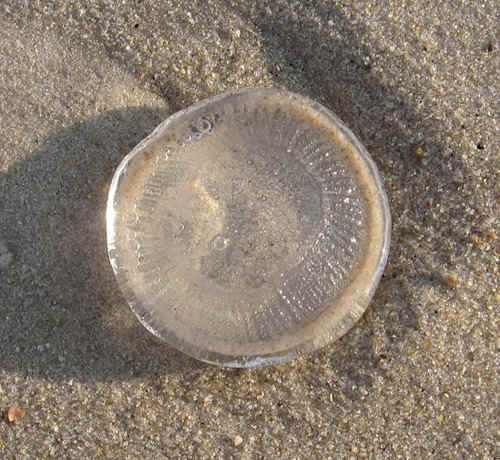
Moon Jellyfish
Above on a beach; below in the water
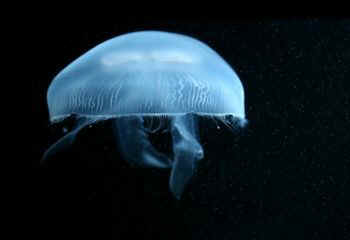
- Cannonball Jellyfish (*)
______ FL
(ASC:507,514) from the Chesapeake Bay to Texas, also
West Indies
Stomolophus meleagris
The Cannonball Jellyfish floats
near shore, sometimes occurring in large swarms.
HYDROIDS (Class Hydrozoa, Order Siphonophora: not true jellyfish)
- Solitary Hydroid ______
(ASC:89) from the Arctic to Long Island Sound
Hybocodon pendula
Hybocodon pendula
is called the "One-armed Jellyfish".
- Tubularian Hydoid ______ DE MD NC VA
(ASC:88) Nova Scotia, Canada to Cape Hatteras NC; also North
American Pacific coast
Tubularia crocea
- Ringed Tubularian ______
Tubularia larynx
- Tall Tubularian ______
Tubularia indivisa
- Sparsely-branched Tubularian ______
Tubularia spectabilis
- Clapper Hydromedusa ______
DE MD (ASC:84,494)
from the Arctic to the Chesapeake Bay
Sarsia tubulosa
- Feathered Hydroid ______
DE FL MD NC VA (ASC:86)
Maine to Florida and Texas, also West Indies
Pennaria tiarella
- Club Hydroid ______
(ASC:87) Labrador to Long Island Sound
Clava leptostyla
- Snail Fur ______ DE
FL MD NC VA (ASC:38) Labrador to Texas, also North American Pacific coast
Hydractinia echinata
- Bougainvillia hydroids ______ DE FL MD NC VA
(ASC:80) from the Arctic to Florida and Texas, also West Indies,
Mexico
Bougainvillia spp.
- Constricted Jellyfish ______
(ASC:497) from the Arctic to Cape Cod MA
Catablema vesicarium
- Stick Hydroid ______ DE
FL MD NC VA (ASC:82) from the Arctic to Texas, also West Indies, Bermuda,
and California
Eudendrium ramosum
Stick Hydroids
resemble a miniature forest. Related species in the Atlantic
are the following three:
- Red Stick Hydroid ______
Eudendrium carneum
- White Stick Hydroid ______
Eudendrium album
- Slender Stick Hydroid ______
Eudendrium tenue
- Many-ribbed Hydromedusa ______ DE FL MD NC VA
(ASC:500) Maine to Texas, also off North American Pacific
coast
Aequorea victoria (has been Aequorea
aequorea)
Aequorea victoria is also called
Crystal Jelly. It (and other related Aequorea
species) are widespread "jellyfish" frequently washed up on
beaches.
Aequorea victoria is luminescent,
and at night one can see the outline of its parts in "living
lights".
- Wine-glass hydroids ______ DE FL MD NC VA
(ASC:77,75) Labrador to the West Indies and Venezuela, also
North American Pacific coast
Campanularia spp.
- Zig-zag Wine-glass Hydroid
______ DE FL MD NC VA
(ASC:78) from the Arctic to the West Indies, also
North American Pacific coast
Obelia geniculata
The medusae of the Zig-zag Wine-glass Hydroid often swim with the bell
turned inside out like a wind-blown umbrella.
- Double-toothed Bushy Wine-glass
Hydroid ______ DE FL MD NC VA
(ASC:79)
Cape Cod MA to the West
Indies
Obelia bidentata
- White-cross Hydromedusa ______
(ASC:501) from the Arctic to Rhode Island
Staurophora metensi
- Eight-ribbed Hydromedusa ______
(ASC:498) from the Arctic to Cape Cod MA
Melicertum octocostatum
The "eight ribs" of Melicertum octocostatum refer to 8 radial
canals and gonads.
- Elegant Hydromedusa ______
DE MD NC VA (ASC:499) from the Arctic to Cape Hatteras NC
Tima formosa
The Elegant Hydromedusa occurs north of Cape Cod MA in the late summer and
fall. It is year-round south of Rhode Island.
- Halecium Hydroid ______
DE MD NC VA (ASC:72)
from the Arctic to Cape Hatteras NC, also North
American Pacific coast
Halecium halecium
- Flared Halecium Hydroid ______
Halecium tenellum
- Bean's Halecium Hydroid ______
Halecium beani
- Graceful Halecium Hydroid ______
Halecium gracile
- Garland Hydroid ______ DE
MD NC VA (ASC:81) from the Arctic to Cape Hatteras NC
Sertularia pumila
- Fern Garland Hydroids ______ (ASC:71)
Labrador to Cape Cod, also North American Pacific coast
Abietinaria spp.
- Silvery Hydroid ______ DE
MD NC VA (ASC:74) from the Arctic to Cape Hatteras NC, also North
American Pacific coast, and Europe
Thuiaria argentea
The graceful Silvery Hydroid is called "White Weed" in England,
where it is collected, dyed green, dried, and shipped to the United States
for sale in flower shops as "Sea Fern".
- Feathery Hydroids ______
DE FL MD NC VA (ASC:67,69)
Cape Cod to Texas, also Bermuda, and in the West
Indies south to Brazil; also North American Pacific coast
Aglaophenia spp.
- Angled Hydromedusa ______
(ASC:505) from the Arctic to Cape Cod MA, also North American
Pacific coast
Gonionemus vertens
- Chain Siphonophore ______ DE
MD
(ASC:487) Nova Scotia, Canada to the Chesapeake Bay
Stephanomia cara
Like other siphonophores, Stephanomia cara
is a floating, free-swimming colony made up of individual polyps.
The colony moves slowly forward by the action of the pulsating bells,
trailing its tentacles.
The Chain Siphonophore is delicate and breaks readily when handled.
- Portuguese Man-of-war (ph) (*)
______ NC(p) NJ(p) (ASC:512,513)
(PAS:31) normally Florida to Texas and Mexico, also
in the West Indies including Bahamas
Physalia physalis
North of the range above, the Portuguese Man-of-war is at times
driven ashore by storms from the Gulf Stream as far north as Cape Cod MA.
The Portuguese Man-of-war is highly toxic.
Its tentacles contain one of the most powerful poisons known in any marine
animal and they can inflict severe burns and blisters even when the animal
is dead on the beach.
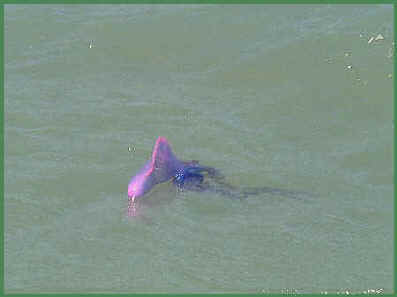
Portuguese Man-of-war
- By the Wind Sailor ______ NC
(ASC:515,516) (PAS:31) in warm waters, off both the
North American Atlantic and Pacific coasts
Velella velella
Velella velella
is a warm-water drifter, sometimes blown ashore from the
Gulf Stream, as far north as Cape Hatteras NC, occasionally further.
Although the tentacles of the "Sailor" contain stinging
cells, they are harmless to man.
- Blue Buttons ______ NC
(ASC:504) in warm waters, off both the North American
Atlantic and Pacific coasts
Porpita linneana
Blue Buttons can be driven ashore from the Gulf Stream by storms as far
north as Cape Hatteras NC, occasionally further.
Since the Blue Buttons does not have a sail, it is blown ashore less
often than the Portuguese Man-of-war or the "Sailor".
in tropical waters, Blue Buttons can be seen by the thousands,
dotting the water with blue for miles.
COMB JELLIES
(Phylum Ctenophora)
- Common Northern Comb Jelly
______ (ASC:491) (PAS:32) from the
Arctic to Cape Cod, uncommon south of Maine
Bolinopsis infundibulum
The Common Northern Comb Jelly is the most common comb jelly
north of Cape Cod occurring in the summer.
- Leidy's Comb Jelly ______ MD
VA (ASC:493) (PAS:32) from
Cape Cod south, but irregular north of New Jersey
Mnemiopsis leidyi
The Leidy's Comb Jelly penetrates the nearly freshwater parts of
estuaries of the Chesapeake Bay.
- Beroe's Comb Jelly
______ (ASC:492) PAS:32) common in the
Gulf of Maine, occurs south to Cape Cod
Beroe cucumis
- Ovate Comb Jelly
______ DE MD VA
(PAS:32) abundant north to the Chesapeake Bay,
regular in the Delaware Bay
Beroe ovata
The above 2 species of Beroe's Comb Jellies are only distinguishable
when they are mature, and not always then.
- Sea Gooseberry ______
DE FL MD NC VA (ASC:496)
(PAS:32) the whole Atlantic Coast (of North America), less
common southward
Pleurobrachia pileus
- Arctic Sea Gooseberry
______ from the Arctic to the Gulf of Maine, sometimes in
winter to Cape Cod; also North American Pacific coast
Mertensia ovum
- Venus Girdle ______ NC
(PAS:32) tropical and oceanic
Cestum veneris
With a ribbon-like body, Cestum veneris
is a Gulf Stream species that is rarely found inshore, most likely in the
late summer and early fall.
MOLLUSKS
(SHELLS) (Phyllum Mollusca)
SEASHELLS are made by MOLLUSKS.
MOLLUSKS are invertebrate animals that produce shells of one or two pieces
that wholly or partially enclose a soft body.
SHELLS are the skeletons of MOLLUSKS. Like the internal skeleton
(endoskeleton) of a mammal, the external skeleton (exoskeleton) of mollusks
function both for protection and as a place for muscle attachment.
A SHELL found on a beach is the skeletal remnant of a dead MOLLUSK.
MOLLUSKS are either snail-like animals with one shell (UNIVALVES, or
GASTROPODS), or clam-like animals with two shells (BIVALVES). The two
shells of a BIVALVE are held tightly together when the animal is alive.
A third group of MOLLUSKS are the CHITONS. An explanation as
to what they are is below.
And another group of MOLLUSKS are the CEPHALOPODS, including SQUIDS and
OCTOPUSES. These animals lack external shells, having instead internal or
rudimentary shells.
CHITONS (Class
Polyplacophora)
CHITONS are flattened, lozenge-shaped
mollusks that are most often found tightly clamped on a rock.
In some species, the shells are completely obscured by the 8 shells down the
CHITON'S back held in place by a girdle.
CHITONS vary in color, with some, as 2 of the species below, being red
- Red Mottled Chiton
______ (ASC:370,374) (PS:74) circumpolar,
along the North American Atlantic coast from the Arctic to Massachusetts
Tonicella marmorea
- Red Northern Chiton
______ (PAS:19) from the
Arctic to Massachusetts Bay, locally south to the Long Island Sound, also
Pacific coast
Tonicella rubra
The Red Northern Chiton
was described by Linnaeus in 1767.
- White Northern Chiton
______ (ASC:380) (AS:444) circumpolar,
along the North American Atlantic coast from Greenland to Massachusetts,
also in the North Pacific in Alaska and south
Ischnochiton albus
The White Northern Chiton was described by Linnaeus in 1767.
- Common Bee Chiton
______ DE MD NC VA (AS:428)
(PAS:19)
(PS:74)
southern Maine to Florida
Chaetopleura apiculata
Another name for Chaetopleura apiculata
is Common Eastern Chiton.
GASTROPODS (Class Gastropoda): snail-like mollusks with a
one-part shell
- Maurer's Slit-shell ______ (PS:39)
off the Carolinas to northeast Florida, a rare species
Perotrochus maureri
- Charleston Sllt-shell ______ (PS:39)
off South Carolina
Perotrochus charlestonensis
LIMPETS
(and KEYHOLE LIMPETS)
- Cup-and-saucer Limpet ______
(PAS:19) Nova Scotia to Florida, rare south of Cape Cod
Crucibulum striatum
- Cayenne Keyhole Limpet ______
FL MD NC VA (ASC:384)
(AS:405) (PS:40) Maryland
to Brazil
Diodora cayenensis
- File Fleshy Limpet
______ FL NC
(AS:402) (PS:40) North Carolina to Brazil
Lucapinella limatula
- Atlantic Plate
Limpet ______ (PS:41) from the Arctic Ocean to New
York
Lottia testudinalis
Lottia testudinalis alveus ______ Eelgrass Limpet
Maine to Connecticut
The largest specimens of Lottia testudinalis are found in the vicinity of
Eastport, Maine.
- Tortoise-shell
Limpet ______ (ASC:383) (AS:386) (PAS:19)
from the Arctic to Long Island Sound
Notoacmaca testudinalis
Another name for Notoacmaca
testudinalis is Atlantic Plate Limpet.
- Northern Blind
Limpet ______ (PS:41) Greenland to Massachusetts
Lepeta caeca
- Linne's Puncturella
______ (AS:409) (PS:41) circumpolar, in the western Atlantic south
to Massachusetts
Puncturella noachina (or Puncturella princeps)
Linne's Puncturella was described by Linnaeus in 1771.
MARGARITES
- Northern Rosy Margarite
______ (AS:257) (PS:43) Greenland to Massachusetts,
also North American Pacific coast
Margarites costalis
Another name for Margarites costalis
is Northern Ridged Margarite.
- Striate Margarite ______
(AS:300) from the Arctic to Massachusetts, also
Europe
Margarites striatus
- Greenland Margarite ______ (ASC:468)
(PS:43) Greenland to Massachusetts
Margarites groenlandicus
Another name for Margarites groenlandicus is
Greenland Top Snail.
- Smooth Margarite
______ (AS:293,681) (PS:43) Greenland to Massachusetts
Margarites helicinus
Another name for Margarites
helicinus is Helicina Margarite.
- Otto's Spiny Margarite
______ DE MD NC VA Newfoundland to North Carolina
Lischkeia ottoi
TOP SHELLS
- Channeled Top
Shell ______ FL NC VA
Virginia to Florida
Solariella lacunella
- Ornate Top Shell
______ DE MD VA
(AS:301) Labrador to Virginia
Solariella obscura
Another name for
Solariella obscura
is Obscure Solarielle.
- Little Ridged Top
Shell ______ (AS:313) Labrador to Maine
Solariella varicosa
Another name for
Solariella varicosa
is Varicose Solarielle.
- Sculptured Top
Shell ______ FL NC
(AS:263) (PS:41) Cape Hatteras to Mexico
Calliostoma euglyptum
- Jubjube Top Shell
______ FL NC
(AS:264) (PS:41)
Cape Hatteras to Brazil
Calliostoma jujubinum
The Jubjube Top Shell is the most
common of the shells in the Calliostoma
genus along the North American Atlantic coast.
It is often washed up on beaches.
- North Atlantic Top
Shell ______ (ASC:458) (AS:253) (PS:41) Nova Scotia to
Massachusetts
Calliostoma occidentalis
Another name for Calliostoma occidentalis is
Pearly Top Snail.
- Beautiful Top
Shell ______ FL NC
(AS:262) (PS:41)
North Carolina to the West Indies
Calliostoma pulchrum
- Dall's Rosy Top
Shell ______ North Carolina to the West Indies
Calliostoma roseolum
LIOTIA SHELLS
The following genus ARENE
has formerly been placed in either the family TURBINIDAE or the family
CYCLOSTREMATIDAE.
- Gem Arene
______ FL NC (AS:274)
North Carolina to the West Indies
Arene tricarinata
- Variable Arene
______ North Carolina to the West Indies
Arene variabilis
The Variable Arene is more common than the Gem Arene, but Arene variabilis
lives in deeper water and is found only by dredging.
TURBANS
- Knobby Turban
______ FL NC
(AS:271) (PS:42) North Carolina to the West Indies and
south to Brazil
Turbo castaneus
Another name for
Turbo castaneus
is Chestnut Turban.
PHEASANT SHELLS
- Umbilicate Pheasant
Shell ______ FL NC (PS:43) off North Carolina to Brazil
Tricolia thalassicola (formerly Phasianella umbilicata)
The Umbilicate Pheasant Shell was described in 1958.
CHINK SHELLS
-
Northern Lacuna ______ (ASC:474) (PAS:20) (PS:43)
from the Arctic to Staten Island NY
Lacuna vincta
Lacuna vincta
is also referred to as the Chink Snail, or Chink Shell.
PERIWINKLES
- Common Periwinkle
______ DE (ASC:472)
(PAS:20) (PS:44) Labrador to Maryland
Littorjna littorea
Littorina irrorata is said to
have been brought to North America from Europe more than a century ago, with
the first in Halifax, Nova Scotia in 1857.
The Common Periwinkle was described by Linnaeus in 1758.
- Marsh Periwinkle ______ FL
NC (ASC:473) (PAS:20) (PS:44) Maryland
to the Gulf of Mexico
Littorina irrorata
Another name for Littorina irrorata is
Gulf Periwinkle. In the past, it
existed further north, as post-Pleistocene fossil specimens are commonly
washed ashore (for example, along the Connecticut coast).
- Angulate
Periwinkle ______ FL from
south Florida to Brazil, in mangroves
Littorina angulifera
- Northern Yellow
Periwinkle ______
(ASC:469) (PAS:20) (PS:44) from the Arctic to
Long Island
Littorina obtusata
Another name for Littorina obtusata is
Smooth Periwinkle. It was described
by Linnaeus in 1758.
- Northern Rough Periwinkle
______ (ASC:470) (PS:43) from the
Arctic Ocean to New Jersey
Littorina saxatilis
SWAMP SNAILS
- Minute Hydrobia
______ Labrador to New Jersey
Hydrobia totteni
RISSOIDS
- Decussate Risso
______ FL NC
(PS:45) North Carolina to the West Indies
Rissoina decussata
- Smooth Risso
______ FL NC (PS:45)
North Carolina to the West Indies, also
Bermuda
Zebina browniana
VITRINELLA SHELL
- Beau's Vitrinella
______ FL NC
(PS:45) from the Carolinas to Brazil
Cyclostremiscus beaui
CAECUMS
- Cooper's Atlantic Caecum
______ DE FL MD NC VA
Massachusetts to Florida
Caecum cooperi
- Beautiful Caecum
______ DE FL MD NC VA
Massachusetts to Florida
Caecum pulchellum
As it is so tiny, Caecum pulchellum could easily be missed by most searchers
at the seashore.
SKENEA SNAIL
- Flat-coiled Skeneopsis
______ DE FL MD NC VA
Greenland to Florida
Skeneopsis planorbis
ATOM SNAIL
- Atom Snail
______ Maine to Rhode Island
Omalogyra atomus
TURRET SHELLS and WORM SHELLS
- Boring Turret Shell ______ FL
NC (ASC:399)
(PS:47) North Carolina to the West Indies
Turritella acropora
- Eroded Turret
Shell ______ (PS:42)
Labrador to Massachusetts
Tachyrhynchus erosum
- Knorr's Worm Shell
______ FL NC
(PS:42) North Carolina to the West Indies, also
Bermuda
Vermicularia knorri
The Knorr's Worm Shell is chiefly in sponges.
- Common Worm Snail (or Common Worm
Shell) ______ FL
(ASC:475) (PAS:28) (PS:42) Florida
to the West Indies
Vermicularia spirata
The Common Worm Snail has been said to occur in New England, notably
Massachusetts, and especially Martha's Vineyard.
That population is considered by some to be a separate species, Vermicularia
radicula.
- Decussate Worm
Shell ______ FL NC
(PS:42) North Carolina to the West
Indies
Serpulorbis decussata
- Slit Worm Shell
______ (PS:42) off North Carolina to Brazil, also Bermuda
Siliquaria squamata
SUNDIALS
- Common Sundial ______ FL
NC
(ASC:433) (PS:47) North Carolina to Brazil
Architectonica nobilis (has been Solarium
granulatum)
- Orbigny's Sundial
______ FL NC
(PS:43) North Carolina to Brazil, also Bermuda
Heliacus bisulcatus
- Krebs' Sundial
______ FL NC
(PS:44) North Carolina to Brazil, also
Bermuda
Philippia krebsi
MODULUS
- Atlantic Modulus
______ FL NC
(PS:46) off North Carolina to Brazil, also Bermuda
Modulus modulus
The Atlantic Modulus was described by Linnaeus in 1758.
HORN SHELLS
- Ladder Horn Snail ______
FL (PS:46) South Carolina to the West Indies, also Bermuda
Cerithidea
scalariformis
CERITHS and BITTIUMS (and the SARGASSUM SNAIL)
- Florida Cerith ______
FL NC
(ASC:402) (PS:46) North Carolina to Brazil
Cerithium atratum (or Cerithium
floridanum)
- Alternate Bittium ______ DE
MD VA (ASC:405)
(PAS:21) (PS:45) Massachusetts to Virginia
Bittium alternatum
- Variable Bittium ______ MD
FL NC VA
(PAS:21) (PS:45) Maryland to Texas
Bittium varium
- Sargassum Snail
______ FL NC (PS:53)
Massachusetts to the West Indies
Litiopa melanostoma
The Sargassum Snail is a pelagic gastropod that lives in floating masses of
sargassum weed.
specimens have been found in clumps blown ashore.
- Awl Miniature Cerith
______ DE FL MD NC VA
Massachusetts to Brazil
Cerithiopsis emersoni
- Green's Miniature Cerith
______ DE FL MD NC VA
Massachusetts to Brazil, also Bermuda
Cerithiopsis greeni
- Adams' Miniature Cerith
______ DE FL MD NC VA
(PS:53) Massachusetts to the West Indies
Seila adamsi (was Cerithiopsis terebralis)
TRIPHORAS
- White Triphora
______ (PS:45) off North Carolina to Brazil, also
Bermuda
Triphora melanura
- Black-lined Triphora
______ DE FL MD NC VA
Massachusetts to Brazil, also Bermuda
Triphora nigrocinta
- Thomas' Triphora
______ FL NC North Carolina to Brazil, also Bermuda
Triforis turristhomae
PURPLE SEA SNAILS
- Elongated Purple Sea Snail
______ FL NC (PS:47) the North American Atlantic coast in warm
waters; also the Pacific coast
Janthina
globosa
- Common Purple Sea Snail ______ (ASC:466) (PAS:22)
(PS:47)
washes ashore north to Cape Cod; also Pacific coast
Janthina janthina
Janthina janthina
is also called Violet Snail. It
was described by Linnaeus in 1758.
Janthina janthina
is a visitor from far offshore. It is a Gulf Stream
drifter supported at sea by a froth of bubbles.
- Dwarf Purple Sea Snail ______ FL NC
(PS:47) the North American Atlantic coast in warm waters; also
Pacific coast
Janthina exigua
- Pallid Purple Sea Snail ______
FL (PS:47) worldwide in warm seas, pelagic
Janthina pallida
WENTLETRAPS
- Northern Wentletrap ______
(PS:48) from the Arctic Ocean to Massachusetts
Acirsa borealis
- Dall's Wentletrap ______ FL
NC (PS:48) North Carolina to Brazil
Cirsotrema dalli
- Angulate Wentletrap ______ DE
FL MD NC VA (ASC:395)
(PS:48) Long Island NY to Texas, also Bermuda
Epitonium angulatum
- Champion's Wentletrap
______ DE MD NC VA
(PS:48) Massachusetts to North Carolina
Epitonium championi
The Champion's Wentletrap was described in 1952.
- Greenland Wentletrap ______ (ASC:394)
(PAS:21) (PS:48) circumpolar, in the western Atlantic
south to Long Island
Epitonium
greenlandicum
The Greenland Wentletrap is one of the showy shells of the North Atlantic.
It makes up in bizarre sculpture what it lacks in size.
Epitonium greenlandicum lives in deep water.
- Humphrey's Wentletrap
______ DE FL MD NC VA
(PS:48) Massachusetts to Texas
Epitonium humphreysi
- Krebs' Wentletrap
______ FL (PS:48)
South Carolina to Brazil, also
Bermuda
Epitonium krebsii
- Many-ribbed Wentletrap
______ DE FL MD NC VA
(PS:48) Massachusetts to Texas, also Bermuda
Epitonium multistriatum
- New England Wentletrap
______ FL NC VA (PS:48)
Virginia to Brazil
Epitonium novangliae
The first specimen of Epitonium novangliae was taken from the stomach of a
cod fish in New England, hence both the common and the scientific names.
However, not other specimens have ever been found alive north of Virginia.
- Western Atlantic
Wentletrap ______ FL
(PS:48) South Carolina to Brazil,
also Bermuda
Epitonium occidentalis
- Brown-banded Wentletrap
______ DE FL MD NC VA
(PS:48) Massachusetts to Texas
Epitonium rupicola (was Epitonium lineatum)
- Noble Wentletrap
______ FL NC
(PS:48) North Carolina to the West Indies
Sthenorhytis pernobilis
FOSSARUS
- Elegant Fossarus
______ DE FL MD NC VA
(PS:45) Massachusetts to Florida
Fossarus elegans
HAIRY-KEELED SNAIL, CAP SHELLS
- Northern Hairy-keeled
Snail ______ Labrador to Massachusetts
Trichotropis borealis
- Incurved Cap Shell
______ FL NC
(PS:49) North Carolina to Brazil
Capulus incurvatus
- Cap Shell
______ DE FL MD NC VA
(PS:47) Greenland to the West Indies
Capulus ungaricus
The Cap Shell was described by Linnaeus in 1767.
CUP-AND-SAUCER LIMPETS, SLIPPER SHELLS
- Circular Cup-and-saucer
Limpet ______ FL NC
(PS:45) Cape Hatteras to the West
Indies
Calyptraea centralis
- Striate
Cup-and-saucer Limpet ______ DE
FL MD NC VA (PS:49)
Nova Scotia to Florida
Crucibulum striatum
- Common Slipper Snail ______ DE
FL MD NC VA
(ASC:462) (PAS:19) (PS:49) Massachusetts to the Gulf of Mexico
Crepidula fornicata
North of the range above, Crepidula fornicata occurs locally to the Gulf of
St. Lawrence, and it has occurred as an accidental in Europe.
The Common Slipper Shell was described by Linnaeus in 1758.
- Spiny Slipper Shell ______
FL NC (PS:49) North Carolina to the West Indies, also Bermuda, and
the North American Pacific coast
Crepidula aculeata
- Convex Slipper Shell ______ DE
FL MD NC VA (PS:49) Massachusetts to the West Indies
Crepidula convexa
- Eastern White Slipper Snail
______ DE FL MD NC VA (PS:49)
Nova Scotia to Brazil, also Bermuda
Crepidula plana
CARRIER SHELL
- Atlantic Carrier
Shell ______ FL NC
(PS:51) North Carolina to Brazil
Xenophora conchyliophora
PELICAN'S FOOT SHELL
- American Pelican's
Foot ______ DE MD NC VA
(PS:47) Labrador to North Carolina
Aporrhais occidentalis
CONCH
- Florida Fighting Conch ______ FL
NC (PS:8,50) North Carolina to Texas and northeast Mexico
Strombus alatus
LAMELLARIA SHELL
- Smooth Velutina
______ along the North American Atlantic coast, from Labrador to
Massachusetts
Velutina velutina
ERATO SNAILS and TRIVIAS
- Mauger's Erato
______ FL NC
(PS:53) North Carolina to Brazil
Erato maugeriae
- Antillean Trivia
______ FL NC
(PS:53) North Carolina to Brazil
Trivia antillarum
- Little White
Trivia ______ FL NC (PS:53)
North Carolina to the Lesser
Antilles
Trivia candidula
COWRIES
- Atlantic Deer Cowrie _____ FL (PS:10,51)
off North Carolina to Cuba, also Bermuda
Cypraea cervus
The Atlantic Deer Cowrie was described by Linnaeus in 1771.
- Yellow Cowrie
______ FL (PS:10,51) off North Carolina to Brazil, also
Bermuda
Cypraea spurca acicularis
SIMNIAS
- Common West Indian Simnia
______ FL NC (PS:9,53) North Carolina to Brazil, also
Bermuda
Simnia
acicularis
- Single-toothed Simnia ______ FL
NC (PS:53)
North Carolina to the West Indies
Simnia
uniplicata
- Flamingo Tongue (ph)
______ FL NC (ASC:449)
(PS:9,49) North Carolina to Brazil, also Bermuda
Cyphoma gibbosum
The Flamingo Tongue was
described by Linnaeus in 1758. This hump-backed gastropod is generally found
living on a sea fan or some other branching aquatic growth, where it clings
tightly to one of the stems.
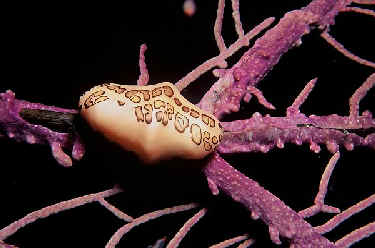
Flamingo Tongue
MOON SHELLS and
NATICAS
- Shark Eye (ph) ______
DE FL MD NC VA (ASC:467)
(PSA:22) (PS:54) Massachusetts Bay to the Gulf of Mexico
Polinices duplicatus
Another name for Polinices duplicatus
is Lobed Moon Shell.
Polinices duplicatus
is the most common moon shell on southern beaches, replacing the Northern
Moon Shell (below, in this list) from New Jersey south.
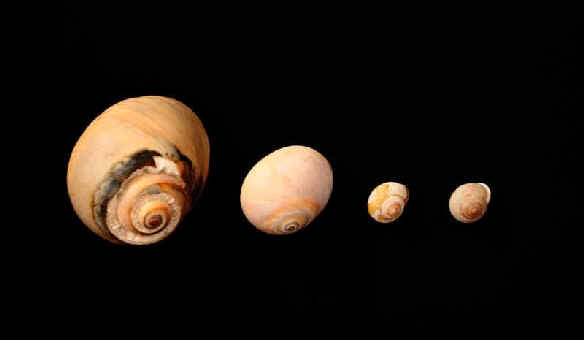
Some Shark Eyes, or Moon Shells
(photo by Marie Gardner)
- Immaculate Moon Shell ______ DE
MD NC VA (PS:53)
Gulf of the St. Lawrence to North Carolina
Polinices immaculatus
- Northern Moon Shell ______ DE
MD NC VA (ASC:461)
(PAS:22) (PS:54) Labrador to North Carolina
Lunatia heros
Lunatia heros
is the most common large moon shell from Long Island north. It
is a deep-water species southward.
- Pale Northern Moon Shell
______ along the North American Atlantic coast, Greenland to New
Jersey
Lunatia pallida
Polinices groenlandica and Polinices borealis
are synonyms of Lunatia
pallida.
- Spotted Northern Moon Shell ______
DE MD NC VA
(PS:54) Gulf of St. Lawrence to North Carolina
Lunatia triseriata
It has been said that the Spotted Northern Moon Shell is the juvenile stage
of the Northern Moon Shell (above), but certain characteristics,
particularly a relatively thick callus on the inner lip, seem to indicate a
mature shell.
- Iceland Moon Shell
______ DE MD VA from the Arctic Ocean to Virginia
Amauropsis islandica
- Colorful Atlantic Natica
______ FL NC (PS:11,54)
North Carolina to Brazil, also Bermuda
Natica canrena
The Colorful Atlantic Natica was described by Linnaeus in 1758.
- Arctic Natica
______ DE MD NC VA
(PS:54) circumpolar, in the western Atlantic from the Arctic Ocean to North
Carolina
Natica clausa
- Southern Miniature Moon Shell ______
DE FL MD NC VA
Maine to
Brazil
Natica pusilla
- Semisulcate Moon
Shell ______ FL NC (PS:54)
North Carolina to the West
Indies, an uncommon species
Sigatica semisulcata
- Common Baby's Ear (or Ear Shell) ______
FL MD NC VA
(ASC:465) (PAS:22) Maryland to Brazil
Sinum perspectivum
Sinum perspectivum
has been reported north to NJ, but it is not common of
Cape Henry, Virginia.
- Maculated Baby's Ear ______
FL NC (PS:54)
North Carolina to the West Indies
Sinum maculatum
HELMET SHELLS
- Emperor Helmet (ph) ______
FL NC
(ASC:434) North Carolina to the West Indies, also
Bermuda
Cassis madagascariensis
Cassis madagascariensis is also known as the Giant Queen Helmet, or simply
the Queen Helmet.
The geographical reference in the scientific name is a misnomer. The shell
does not occur there.
A more rounded form of Cassis madagascariensis with smaller and more
numerous spines, occurring off the shores of the southeastern US, has been
said to be a distinct subspecies, the Clench's Helmet, Cassis
madagascariensis spinella.
It is now, however, considered to be a form of the typical Emperor, or
Queen
Helmet.
- Scotch Bonnet (ph) ______
FL NC (ASC:454) (PAS:22) (PS:13,51)
North Carolina to
Brazil, also Bermuda
Phalium granulatum
The Scotch Bonnet has formerly had the scientific
names Semicassis inflata and Semicassis
abbreviata.
The smooth Polished Scotch Bonnet, that has been said to Phalium
cicatricosum, is a genetic form of Phalium
grannulatum.
The Scotch Bonnet is the "state shell" of
North Carolina.
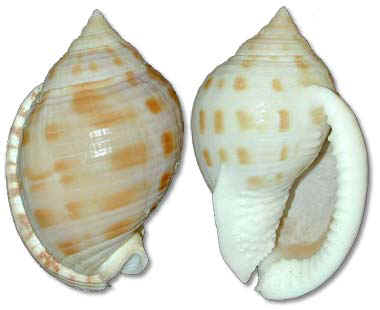
The Scotch Bonnet, on each side
TRITONS
- Dog-head Triton
______ FL (PS:12,55)
South Carolina to the West Indies, also
Bermuda
Cymatium caribbaeum
- Dwarf Hairy Triton
______ FL NC
(PS:55) North Carolina to Brazil, also Bermuda
Cymatium vespaceum
- Atlantic Distorsio
______ FL NC
(PS:55) off North Carolina to Brazil
Distorsio clathrata
- McGinty's Distorsio
______ FL NC
(PS:55) off North Carolina to Brazil, also Bermuda
Distorsio macgintyi
TUN SHELL
- Giant Tun Shell
______ FL NC
(PS:55) North Carolina to Brazil
Tonna galea
The Giant Tun Shell was described by Linnaeus in 1758.
FIG SHELL
- Paper Fig Shell
______ FL NC (PS:57)
North Carolina to the Gulf of Mexico
Ficus communis
The Paper Fig Shell was formerly said to be Ficus, or
Pyrula papyratia.
Carol's Fig Shell, that has been said to be Ficus carolae, may be a
deep-water form of Ficus communis.
MUREX SHELLS (including DRILLS)
- Red Murex
______ FL (PS:58)
off North Carolina to the Bahamas
Murex recurvirostris
- Pitted Murex
______ FL NC
(PS:59) North Carolina to Brazil
Favartia cellulosus
- Giant Eastern
Murex ______ FL NC
(PS:58) North Carolina to Florida and
Texas
Hexaplex fulvescens
- Apple Murex ______ FL
NC
(ASC:437) (PS58) North Carolina to Brazil
Phyllonotus pomum
- Lace Murex ______ FL
NC (ASC:438)
(PS:58) North Carolina to Florida
Chicoreus florifer
dilectus
- Atlantic Oyster Drill ______ DE
FL MD
NC VA (ASC:407) (PAS:20) (PS:59) Cape Cod to
Florida
Urosalpinx cinerea
- Thick-lipped Oyster
Drill ______ DE FL MD
NC VA (PS:59) Massachusetts to Florida
Eupleura caudata
- Clathrate Trophon
______ from the Arctic Ocean to Maine
Boreotrophon clathratus
The Clathrate Trophon was described by Linnaeus in 1758.
ROCK SHELLS and
DOGWINKLES
- Florida Rock Shell ______ FL
NC (ASC:415) (PS:59) North Carolina to Brazil
Thais
haemastoma floridana
The typical Thais
haemastoma is a shell of the Mediterranean.
- Atlantic Dogwinkle ______
(ASC:456) (PAS:20) (PS:59) from the Arctic to the eastern
Long Island Sound
Nucella
lapillus (or Thais lapillus)
The Atlantic Dogwinkle was
described by Linnaeus in 1758.
DOVE SHELLS
- Greedy Dove Snail ______ DE
FL MD NC VA
(ASC:406) Massachusetts to the Yucatan
Anachis avara
- Fat Dove Shell ______ FL
NC VA
Virginia to Uruguay
Anachis obesa
- Well-ribbed Dove Shell ______
DE FL MD NC VA
(PS:62) Maine to Florida and eastern Mexico
Anachis
lafresnayi
Anachis translirata
is a synonym of Anachis lafresnayi.
- Lunar Dove Snail ______ DE
FL MD NC VA (ASC:453)
Massachusetts to Brazil
Mitrella lunata
Another name for Mitrella lunata is
Crescent Mitrella.
NASSA MUD SNAILS
- Eastern Mud Nassa
______ DE FL MD NC VA
(ASC:452) (PAS:20)
(PS:62) Cape Cod to Florida, locally north to the Gulf of St.
Lawrence
Nassarius obsoletus (or Ilyanassa obsoleta)
Another name for Nassarius obsoletus is
Mud Dog Whelk.
- Common Eastern Nassa
______ DE FL MD NC
VA (ASC:413) (PS:62)
Massachusetts to the West Indies
Nassarius vibex
Another name for Nassarius vibex is
Mottled Dog Whelk.
- Variable Nassa
______ FL NC (PS:62)
North Carolina to the West Indies
Nassarius albus
- New England Nassa
______ DE MD NC VA
(ASC:412) (PS:62) Nova Scotia to South
Carolina
Nassarius trivittatus
Another name for Nassarius trivittatus is
New England Dog Whelk.
WHELKS
and CROWN CONCHS
Shells that have been
called DOG WHELKS are in the previous grouping of NASSA MUD
SNAILS.
- Waved Whelk ______ (ASC:408)
(PAS:22) (PS:11,58) from the Arctic south to New Jersey, only in
deep water south of Cape Cod
Buccinum undatum
Another name for Buccinum undatum is
Common Northern Buccinum. It ws
described by Linnaeus in 1758.
The young of Buccinum
undatum are common in tide pools and shallow water in Maine.
- Pygmy Whelk ______ DE
MD NC VA Gulf of St.
Lawrence to North Carolina
Colus pygmaeus
- Spitsbergen Whelk ______ from
the Arctic Ocean south in the western Atlantic to Nova Scotia
Colus spitzbergensis
- Stimpson's Whelk ______ DE
MD NC VA (ASC:424)
(PAS:22) (PS:58) Labrador to Cape Hatteras
Colus stimpsoni
The Stimpson's Whelk is found usually as much-worn beach shells north of
Cape Cod, Massachusetts.
- New England Neptune ______
(PAS:22) (PS:58)
Nova Scotia to Cape Cod
Neptunea decemcostata
Another name for Neptunea decemcostata is
Ten-ridged Whelk.
- Corded Neptune ______ (ASC:420,425)
Neptunea lyrata
Neptunea decemcostata (above) may be considered a subspecies of
Neptunea
lyrata.
- Cande's Phos ______ FL NC
(PS:46) North Carolina to Brazil
Antillophos candes
- Tinted Cantharus ______ FL NC
(PS:60) North Carolina to Brazil, also Bermuda
Pisania tincta
- False Drill ______
FL NC North
Carolina to Texas and the West Indies
Cantharus multangulus
- Channeled Whelk (ph) ______ NC
(ASC:417) (PSA:22) (PS:57) chiefly
from Cape Cod to north Florida
Busycon canaliculatum
The Channeled Whelk is the largest sea snail of the Atlantic coast of
North America. It was described by Linnaeus in 1758.
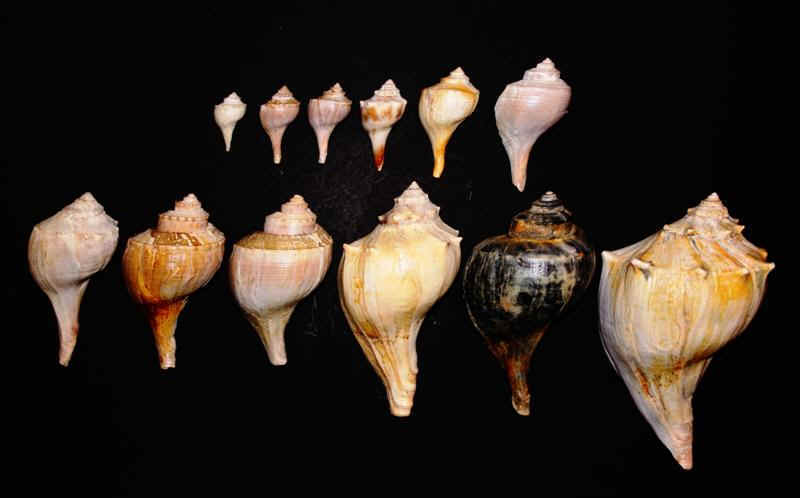
A grouping of Channeled Whelks
(photo by Marie Gardner)
- Knobbed Whelk ______
DE FL MD NC VA (PS:57)
Massachusetts to north Florida
Busycon carica
Busycon carica eliceans ______ Kiener's Whelk FL
NC North
Carolina to east Florida
The Knobbed Whelk is the largest gastropod found north
of Cape Hatteras.
- Lightning Whelk ______ FL
(ASC:427,428) (PS:57) South Carolina to Florida
Busycon contrarium
- Pear Whelk ______
FL NC (PS:57) North Carolina to Florida and the Gulf states
Busycon spiratum
Busycon spiratum pyruloides ______ FL
NC
North Carolina to Florida
Busycon spiratum was
Busycon pyrum.
TULIP
SHELLS (including the HORSE CONCH)
- Florida Horse Conch ______ FL
NC (ASC:426)
(PS:52) North Carolina to Florida and eastern Mexico
Pleuroploca gigantea
(formerly in the genus Fasciolaria)
One of the biggest shells in the
world, the Florida Horse Conch is
easily the largest shelled snail found in American waters. It is up to 24
inches long and 10 inches wide.
Older shells are usually well covered with various bryozoans, barnacles,
tube worms, and other sedentary invertebrates.
The Florida Horse Conch was designated
as the official shell of the state of Florida in 1969.
- True Tulip Shell ______
FL NC (ASC:421) (PS:56)
North Carolina to Brazil
Fasciolaria tulipa
The True Tulip Shell was described by Linnaeus in
1758.
- Banded Tulip Shell ______ FL
NC
(ASC:422) (PS:56)
Fasciolaria lillium
Fasciolaria lillium hunteria ______ FL
NC Cape Hatteras
NC to Florida and west to Alabama
OLIVE SHELLS
OLIVE SHELLS are so-called because their shape
resembles that of an olive pit.
- Lettered Olive ______
FL (ASC:441,442) (PAS:29) (PS:8,60)
South Carolina to Florida
Oliva sayana (was Oliva litterata)
There is a pale yellowish to nearly golden variety of
Oliva sayana that is unspotted. It is called the Golden
Olive, Oliva sayana
citrina, and is sought by collectors.
The Coast Indians, who lived in what is now the southeast US long before
Europeans came, made necklaces of Lettered Olives.
- Common Rice Olive ______ FL
NC (PS:61) North Carolina to Brazil, also Bermuda
Olivella floralia
- Variable Dwarf Olive ______ FL
NC (PS:61) North Carolina to Florida and the Bahamas
Olivella hiplicta
(or Olivella mutica)
- Jasper Dwarf Olive ______ FL
NC (PS:61) North Carolina to Brazil, also Bermuda
Jaspidella jaspidea
MITER SHELL
- Beaded Miter ______
FL NC
(ASC:403) (PS:62) North Carolina to Brazil, also
Bermuda
Mitra nodulosa
(was Mitra granulosa)
VOLUTES
- Gould's Volute ______ FL
NC (PS:63) North Carolina to the West Indies
Scaphella gouldiana
- Junonia ______
FL NC
(ASC:423) (PS:14,63) North Carolina to the Gulf of
Mexico
Scaphella junonia
Another name for Scaphella
junonia is Juno's Volute.
NUTMEGS
- Common Nutmeg ______ FL
NC
(ASC:416) (PS:60) North Carolina to Brazil
Cancellaria reticulata
The Common Nutmeg was described
by Linnaeus in 1767.
Cancellaria conradiana
is a fossil relative of Cancellaria
reticulata.
- Couthouy's Nutmeg ______ in the
western Atlantic, from the Arctic to Massachusetts
Admete couthouyi
- Arrow Dwarf Triton ______ FL
NC (PS:62) North Carolina to Brazil, also Bermuda
Tritonoharpa
lanceolata
MARGINELLAS
- Banded Marginella ______ FL
NC North Carolina to the West Indies
Marginella aureocincta
- Carmine Marginella ______
FL (PS:61) South Carolina to Brazil
Marginella hematita
- Dentate Marginella ______ FL
NC (PS:61) North Carolina to the West Indies
Marginella eburneola
The following
genus, Prunum, is sometimes used as a subgenus of Marginella.
- Common Marginella ______ FL
NC
(ASC:439) (PS:61) North Carolina to the West Indies
Prunum apicinum
- Bell Marginella ______ FL
NC (PS:61) North Carolina to Florida
Prunum bellum
- Orange-banded Marginella ______
FL NC
(PS:61) North Carolina to Brazil, also Bermuda
Hyalina avena
- Oat Marginella ______
FL NC North Carolina to Brazil
Hyalina avenacea
(was Marginella succinea)
- Velie's Marginella ______
FL (PS:61) South Carolina to Florida
Hyalina veliei
CONE SHELLS
- Florida Cone ______ FL
NC (PS:15,64) North Carolina to Florida
Conus floridanus
- Sozon's Cone ______ FL
(PS:64) South Carolina to Florida
Conus delessertii
AUGER SHELLS
- Concave Auger ______ FL
NC
(ASC:397) North Carolina to Brazil
Terebra concava
- Common Atlantic Auger ______ FL
NC VA
(ASC:398) (PAS:22) (PS:61) Virginia to the Gulf of Mexico
Terebra dislocata
- Florida Auger ______
FL (PS:60) South Carolina to Florida
Terebra floridana
- Fine-ribbed Auger ______ FL
NC North Carolina to Texas, and in the West Indies
Terebra protexta
- Salle's Auger ______ NC
North Carolina, and in the West Indies south to Brazil
Terebra salleana
TURRET or TURRID
SHELLS
- Star Turrid ______
FL
(PS:65) off North Carolina to the West Indies
Cochlespira radiata
- Moser's Turret ______
FL NC North Carolina to Florida
Fenimorea moseri
- Oyster Turret ______ (ASC:404)
Crassispira ostrearum
- Cancellate Lora ______ Labrador to Massachusetts
Propebela cancellata
- Harp Lora ______ Labrador
to Rhode Island
Oenopota harpularia
- Plicate Mangelia ______ DE
FL MD NC VA Maine
to Florida
Pyrgocythara plicosa
MELANELLA SHELLS
- Golden-banded Eulima
______ FL NC North Carolina to the West Indies
Melanella auricincta
- Two-lined Balcis ______
FL NC North Carolina to the West Indies
Balcis bilineata
- Cone-like Balcis
______ FL NC Cape Hatteras NC to the West Indies
Balcis conoidea
- Henderson's Niso ______ FL
NC North Carolina to Florida
Niso hendersoni
Henderson's Niso was
described in 1953. It was formerly misidentified as the Eastern Pacific
Niso, Niso interrupta.
PYRAMID SHELLS
- Brilliant Pyram ______
FL NC North Carolina to the West Indies
Pyramidella candida
- Crenate Pyram ______
FL South Carolina to Florida
Pyramidella crenulata
- Bush's Turbonille ______ Martha's Vineyard MA to Long Island Sound
Turbonilla bushiana
- Dall's Turbonille ______ FL
NC North Carolina to Florida
Turbonilla dalli
- Interrupted Turbonille
______ DE FL MD NC
VA Maine to Florida and the West Indies
Turbonilla interrupta
- Claret Turbonille ______ FL
NC North Carolina to Florida
Turbonilla punicea
- Ovid Odostome ______ FL
NC North Carolina to Brazil
Odostomia laevigata
Synonyms for Odostomia
laevigata are Odostomia ovuloides,
Odostomia schwengelae, Odostomia cooperi.
It is a variable species.
- Three-banded Odostome
______ Maine to New Jersey
Odostomia trifida
- Double-sutured Odostome
______ DE FL MD NC VA
Gulf of St. Lawrence to Florida
Boonea bisuturalis
- Incised Odostome ______ DE
FL MD NC VA Massachusetts to Florida
Boonea imprressa
- Half-smooth Odostome
______ DE FL MD NC VA
Prince Edward Island, Canada to Florida
Boonea seminuda
various BUBBLE SHELLS
and allies
including SMALL
BUBBLE SHELLS, TRUE BUBBLE SHELLS, GLASSY BUBBLE SHELLS,
BARREL BUBBLE SHELLS, CANOE SHELLS, BARREL BUBBLES, WIDE-MOUTHED PAPER
BUBBLES
-
Adams' Baby Bubble ______ DE
FL MD NC VA Massachusetts to the West Indies
Acteon punctostriatus (has been placed in the genus
Rictaxis)
- Common Atlantic Bubble
______ FL NC (PS:65)
North Carolina to
Brazil, also Bermuda
Bulla striata
- Solitary Glassy
Bubble ______ DE MD NC
VA Massachusetts to North Carolina
Haminoea solitaria
- Amber Glassy
Bubble ______ DE FL MD
NC VA (PS:65)
Delaware to Texas, also
Bermuda and in the West Indies
Haminoea succinea
- Channeled Barrel
Bubble ______ DE FL MD
NC VA Canada to Mexico
Acteocina canaliculata
The Channeled Barrel Bubble is a diminutive snail that is commonly found
clinging to an old oyster or clam shell, and also on decaying, floating
timbers.
- Cande's Barrel
Bubble ______ FL NC
Cape Hatteras NC to the West Indies
Acteocina candei
- Ivory Barrel
Bubble ______ FL NC
Cape Hatteras NC to Florida
Acteocina eburnea
- Common Canoe Shell
______ DE FL MD NC VA
(PS:65) Gulf of St. Lawrence to the West Indies
Scaphander punctostriatus
- Brown's Barrel
Bubble ______ DE MD NC
VA Greenland to North Carolina
Cylichna alba
- Orbigny's Bubble
______ FL NC North Carolina to Brazil
Cylichna bidenata
- File Paper Bubble
______ from the Arctic Ocean to Massachusetts
Philine lima (was Philine lineolata)
- Quadrate Paper
Bubble ______ DE MD NC
VA Greenland to North Carolina
Philine quadrata
ELLOBIUM SHELLS
- Eastern Melampus
______ DE FL MD NC VA
(AS:361)
(ASC:446,448) (PAS:20) Gulf of St. Lawrence to Gulf of Mexico, also Bermuda
Melampus bidentatus (was Melampus
lineatus)
Melampus bidentatus is also called the Salt-marsh Snail.
- Florida Melampus
______ DE MD NC VA
Delaware to Louisiana
Melampus floridana
TUSK SHELLS (Class
Scaphopoda)
- Ivory Tusk Shell
______ FL NC (PS:17)
North Carolina to Texas, and the West
Indies
Graptacme eboreum
- Ribbed Tusk Shell
______ DE MD NC VA
Newfoundland to Cape Hatteras
Antalis occidentalis
- Texas Tusk Shell
______ FL NC North Carolina to Texas
Dentalium americanum
- Paneled Tusk Shell
______ FL NC North Carolina to the West Indies
Dentalium laqueatum
- Carolina Cadulus
______ FL NC North Carolina to Texas
Polyschides carolinensis
The Carolina Cadulus is in a grouping of SWOLLEN TUSK SHELLS.
The following 3
groups, SEA BUTTERFLIES, SEA HARES, and NUDIBRANCHS, are in
the Class Gastropoda.
SEA BUTTERFLIES (and NAKED SEA
BUTTERFLIES)
- Gibbose Cavoline
______ worldwide, pelagic in temperate and tropical seas
Cavolinia gibbosa
- Inflexed Cavoline
______ in the Atlantic Ocean, pelagic in temperate and tropical waters
Cavolinia inflexa
- Long-snout Cavoline
______ Martha's Vineyard MA south to the Gulf of Mexico and the
South Atlantic Ocean
Cavolinia longirostris
- Three-toothed Cavoline
______ (PS:65) worldwide, pelagic in temperate and
tropical seas
Cavolinia tridentata
- Uncinate Cavoline
______ worldwide, in temperate and tropical seas
Cavolinia uncinata
- Three-spined Cavoline
______ worldwide, pelagic in temperate and tropical seas
Diacria trispinosa
- Four-toothed Cavoline
______ worldwide, pelagic in temperate and tropical seas
Diacria quadridentata
- Cuspidate Clio
______ worldwide, pelagic in temperate and tropical seas
Clio cuspidata
- Pyramid Clio
______ worldwide, in arctic and temperate seas
Clio pyramidata
The Pyramid Clio was described by Linnaeus in 1767.
- Wavy Clio
______ (PS:65) worldwide, in warm and temperate
seas
Clio recurva
- Common Clione
______ DE MD NC VA (PS:68)
in the Atlantic off North America from the
Arctic to North Carolina, also Pacific coast
Clione limacina
Common Clione
is a food of whales. Sometimes it is washed ashore after
strong winds.
- Keeled Clio
______ worldwide, pelagic in temperate and tropical seas
Styliola subula
- Straight Needle Pteropod
______ worldwide, pelagic in temperate and tropical seas
Creseis acicula
- Curved Needle Pteropod
______ in the Atlantic and Pacific Oceans, pelagic, can be abundant
near the ocean surface
Creseis virgula
- Cigar Pteropod
______ worldwide, pelagic in temperate and tropical seas
Cuvierina columnella (was Herse columnella)
SEA
HARES (and STILIGER)
SEA HARES are
so-called because of the resemblance of their second pair of antennae to a hare's
long ears, and the similarity of the animal's general shape to that of a
crouched hare.
- Willcox's Sea Hare ______ DE
FL MD NC VA
(PAS:30) (PS:66) Cape Cod to the Gulf of Mexico
Aplysia
willcoxi
Synonyms of
Aplysia willcoxi
are
Aplysia floridensis
and
Aplysia brasiliana.
- Ragged Sea Hare ______
FL NC
(ASC:148) (PS:66) North Carolina to Brazil
Bursatella leachi
- Dusky Stiliger ______
DE MD VA (PS:70)
New Hampshire to Virginia
Stiliger
fuscata
NUDIBRANCHS
and allies
NUDIBRANCHS are
multi-colored "sea slugs" that, because of their delicate
beauty, have been called "butterflies of the sea".
- Hairy Doris ______
(ASC:222) along the North
American Atlantic coast from the Arctic to Connecticut, also Pacific
coast
Acanthodoris pilosa
- Atlantic Ancula ______
(ASC:205) from the Arctic to Massachusetts
Ancula gibbosa
- White Atlantic Cadlina ______ (ASC:223)
from the Arctic to Cape Cod MA, also Europe
Cadlina laevis
Another name for Cadlina laevis is White Atlantic Doris.
It was described by
Linnaeus in 1767.
- Rough-mantled Doris ______
(ASC:229,230) along the North
American Atlantic coast from the Bay of Fundy to Rhode Island, also Pacific
coast
Onchidoris bilamellata
- Bushy-backed Sea Slug ______
(ASC:208) along the Atlantic
coast from the Arctic to New Jersey, also Pacific coast
Dendronotus frondosus
- Red-gilled Nudibranch ______ (ASC:202)
(PAS:45) along the Atlantic coast from the Arctic to Cape Cod,
also Pacific coast
Coryphella
rufibranchialis
- Salmon-gilled Nudibranch ______
(ASC:203,204) Greenland to Massachusetts Bay
Coryphella salmonacea
- Maned Nudibranch ______ (PAS:45)
(PS:73)
along the Atlantic coast from Bay of Fundy to Cape Cod, rarely south to Maryland,
also North Pacific and Europe
Aeolidia papillosa
Another name for Aeolidia papillosa is
Papillose Eolis.
- Frond Eolis
______ (PS:71) from Arctic seas to New Jersey, also
Pacific coast of North America, and Europe and Japan
Dendronotus frondosus
- Dubious Polycera
______ (PS:70) Greenland and from Labrador to Connecticut
Polycera dubia
- Humm's Polycera
______ FL NC North Carolina to northern Florida
Polycera hummi
- Coronate Doto
______ DE MD NC VA
(PS:72) Newfoundland, and eastern US, also
Europe
Doto coronata
- Boston Facelina
______ (PS:72) Nova Scotia to Connecticut
Facelina bostoniensis
- Western Atlantic Dondice
______ FL NC (PS:73)
North Carolina to Brazil
Dondice occidentalis
BIVALVES (Class
Bivalva)
- Boreal Awning Clam ______ (PS:19)
Nova Scotia to Connecticut
Solemya borealis
- Atlantic Awning Clam ______ DE FL MD NC VA
(PS:18) Nova Scotia
to Florida
Solemya velum
- Atlantic Nut Clam (or
Near Nut Shell) ______ DE
FL MD NC VA (ASC:329)
(PAS:23) Maine to Florida
Nucula proxima
- Cancellate Nut Clam ______ DE MD VA
Cape Cod to Virginia
Nucula atacellana
- Delphinula Nut Clam ______ DE MD
(PS:18) Labrador to Maryland
Nucula delphinodonta
- Atlantic Nut Clam ______ DE FL MD NC VA
(PS:18) Nova Scotia
to Texas, also Bermuda
Nucula proxima
- Smooth Nut Clam ______ DE
MD (PS:18) Labrador to Maryland
Nucula tenuis
The Smooth Nut Clam has been said to be Nucula expansa.
- Pointed Nut Clam ______ DE FL MD NC VA
(PS:18) Massachusetts to Texas, also in the West Indies
Nuculana acuta
- Carpenter's Nut Clam ______ FL NC
(PS:18) North Carolina to the West Indies
Nuculana carpenteri
- Minute Nut Clam ______ Labrador to Maine
Nuculana minuta
- Muller's Nut Clam ______ Greenland to
Massachusetts
Nuculana pernula
- Thin Nut Clam (or Sulcate
Nut Clam) ______
(ASC:301) Gulf of the St. Lawrence to Rhode Island
Nuculana
tenuisulcata
Nuculana tenuisulcata
has common been found in the stomachs of
codfish.
- Arctic Yoldia ______ Greenland to the Gulf of St. Lawrence
Yoldia arctica
- File Yoldia ______ (ASC:300)
(PAS:23) (PS:19) Gulf of St. Lawrence to Long Island Sound
Yoldia limatula
- Comb Yoldia ______
(PS:18) Labrador to Massachusetts
Yoldsia myalis
- Short Yoldia ______ DE
MD NC VA (PS:18)
Labrador to North Carolina
Yoldia sapotilla
- Broad Yoldia ______ DE
MD NC VA (PS:19)
from the Arctic Ocean south
to North Carolina
Yoldia thraciaeformis
- Veiled Clam ______ DE
FL MD NC VA (PAS:23)
Nova Scotia to Florida
Solemya velum
- Mossy Ark ______ FL
NC (PS:19) North
Carolina to the West Indies, and Brazil, Bermuda
Arca imbricata
- Turkey Wing ______ FL
NC (PS:19) North
Carolina to the West Indies, also Bermuda
Arca zebra
- White-bearded Ark ______
FL NC
(ASC:323) (PS:19) North Carolina to Texas, and in the
West Indies
Barbatia candida
- White Miniature Ark ______ FL
NC (PS:18) Cape
Hatteras, NC to the West Indies, also Bermuda
Barbatia domingensis
- Adams' Miniature Ark ______ FL
NC (PS:18) Cape
Hatteras, NC to Brazil
Arcopsis adamsi
- Incongruous Ark ______ FL
NC (PS:19) North
Carolina to Brazil
Anadata brasiliana
- Cut-ribbed Ark ______ FL
NC (PS:19) North
Carolina to Texas and in the West Indies
Anadata floridana
- Blood Ark ______ DE
FL MD NC VA (ASC:369)
(PS:19) Massachusetts to the West Indies, and to
Brazil
Anadara ovalis
- Transverse Ark ______
DE FL MD NC VA
(PS:19) Massachusetts to Texas, and in the West
Indies
Anadara transversa
- Ponderous Ark ______ FL
NC (ASC:367)
(PAS:26) (PS:19) Cape Cod to Gulf of Mexico, shells north of
VA are probably fossils
Noetia ponderosa
- Sulcate Limopsis ______ DE
FL MD NC VA
(PS:19) Massachusetts to the West Indies
Limopsis sulcata
- American Bittersweet ______ FL
NC VA (PS:19)
Virginia to Brazil
Glycymeris americana
- Comb Bittersweet ______ FL
NC (ASC:365) (PS:19) North
Carolina to the West Indies
Glycymeris pectinata
- Atlantic Bittersweet ______ FL
NC (PS:19) North
Carolina to the West Indies, and to Brazil
Glycymeris
undata
The Atlantic Bittersweet
was described by Linnaeus in 1758.
MUSSELS
MUSSELS
are
popular bivalve molluscs that have oval blue-black shells. The mussel
meat varies in color from a deep ochre to pale taupe, depending on where
they have been harvested.
Mussels are harvested in the wild, but they are also extensively
farmed on ropes or stakes and in sheltered beds. They are commonly regarded
as one of the most sustainable types of seafood.
Available year-round, mussels are at times sold live in the shell,
while at other times and places precooked or canned in brine or vinegar.
Smoked mussels are also available.
Although most commercially available mussels are farmed, which
guarantees a high level of cleanliness, they should still be thoroughly
scrubbed under cold, running water, but not left to soak in the water.
Mussels should be discarded if they broken or damaged shells or open
ones that do not shut immediately when sharply tapped (referring to live
mussels).
With a sweet flavor and creamy texture, mussels can be steamed with
lemon and parsley, or stuffed and baked to make a classic antipasti.
A substitute for mussels can be clams.
- Northern Horse Mussel ______ DE
FL MD NC VA (ASC:294)
(PAS:24) (PS:20) Circumpolar, south to northern
Florida
Modiolus modiolus
Modiolus modiolus squamosus ______
False Tulip Mussel FL NC
North Carolina to the West Indies
The Northern Horse Mussel was
described by Linnaeus in 1758. It is considered
inedible.
- Tulip Mussel ______ FL
NC (PS:20) North
Carolina to the West Indies
Modiolus americanus
- Ribbed Mussel ______ DE
FL MD NC VA (ASC:295)
(PAS:24) (PS:20) Cape Cod to Florida, locally north to Gulf
of St. Lawrence
Ischadium demissum (or
Modiolus demissus)
- Hooked Mussel ______ DE
FL MD NC VA (PS:18)
Cape Cod, MA to the West Indies
Ischadium recurvum
- Blue Mussel (ph) ______ DE
MD NC VA
(ASC:293) (PAS:24) (PS:20) circumpolar, south to South Carolina
Mytilus edulis
The Blue Mussel was described by Linnaeus in 1758.
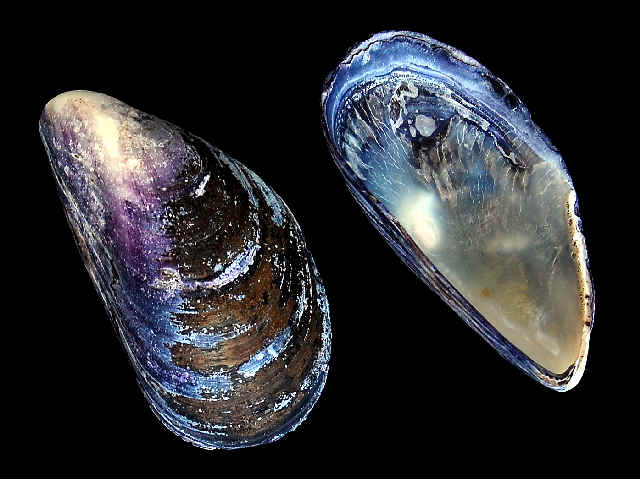
Above: shells of Blue Mussel
Below: not only do people enjoy the taste of mussels,
so do cats, including this one named Herman.
Before he began drinking the juice, he put his paw into the bowl.
In the next photo below, there's a shell much like his paw.
(lower photo by Rise Hill)
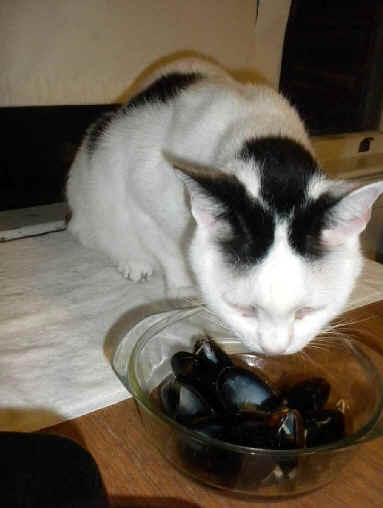
- Scorched Mussel ______
FL
NC (PS:18) Cape Hatteras to the West Indies, and to
Brazil
Brachidontes exustus
The Scorched Mussel was described by Linnaeus in 1758.
- Artist's Mussel ______ FL
NC (PS:21) North Carolina to the West Indies
Gregariella coralliophaga
The Artist's Mussel has been said to be Mytilus opifex. It is a variable
species.
- Paper Mussel ______ FL
MD NC VA (PS:18)
Maryland to Florida
Amydalum papyrium
- Discord Mussel ______ Labrador
to Long Island, NY
Musculus discors
The Discord Mussel was described by Linnaeus in 1767.
- Lateral Mussel ______
FL
NC (PS:23) North Carolina to the West Indies, and to Brazil
Musculus lateralis
- Little Black Mussel
______ DE MD NC VA from the Arctic
Ocean to North Carolina
Musculus niger
- Little Bean Mussel ______
Greenland to Nova Scotia
Crenella faba
- Grandular Bean Mussel
______ DE MD NC VA
Labrador to North Carolina
Crenella glandula
- Cinnamon Mussel ______
FL
NC (PS:20) North Carolina to the West Indies, also Bermuda
Botula fusca
- Scissor Date Mussel
______ FL NC
(PS:20) North Carolina to the West Indies
Lithophaga aristata
- Mahogany Date Mussel ______
FL NC (PS:20) North Carolina to the West Indies, also Bermuda
Lithophaga bisulcata
- False Zebra Mussel
______ DE FL MD NC VA
(PS:21,26) New York to Texas
Mytilopsis leucophaeata
PEARL OYSTER
- Atlantic Winged Oyster ______
FL NC (PS:21) North Carolina to Brazil, also Bermuda
Pteria colymbus
PEN SHELLS
- Half-naked Pen Shell
______ FL NC North Carolina to Argentina
Atrina seminuda
The Half-naked Pen Shell (above) and the Stiff Pen
Shell (below) occupy the same range in North America and can not
externally be distinguished from each other, although the Half-naked Pen
Shell is usually a more tan-purple coloration.
Differences are in the soft parts and muscle scars.
- Stiff Pen Shell ______ FL
NC (ASC298,354) (PS:21) North Carolina to the
West Indies
Atrina rigida
- Saw-toothed Pen Shell ______ FL
NC (ASC:299) (PS:21) North Carolina to the
West Indies
Atrina serrata
SCALLOPS (and
the Kitten's Paw)
- Kitten's Paw (ph) ______ FL
NC (ASC:361) (PS:25)
North Carolina to the
West Indies
Plicatula gibbosa
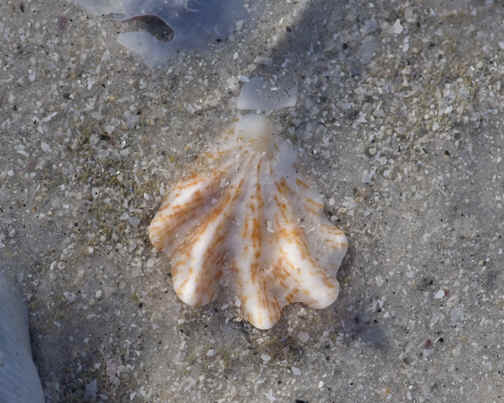
Kitten's Paw
The following 4 genera are in the family
PECTINIDAE, the SCALLOPS.
With pretty fan-shaped corrugated shells, SCALLOPS are an appreciated
shellfish found in most oceans of the world.
SCALLOPS are bivalve molluscs, but unlike others, they live in
deeper waters and move freely by expelling water from their shells.
SCALLOPS are both harvested in the wild and farmed in some countries.
Harvesting by hand-divers is more environmentally sound than dredging.
A freshly opened scallop reveals a fill or skirt around the edge,
gills and intestinal sac, all of which are discarded.
The edible jewels are the white disc of meat (abductor muscle) and the
coral-colored roe. The white meat is sweet, succulent and tender, while the
coral has a stronger flavor. In some countries, the coral is either dried
for use in sauces or discarded altogether.
Scallop dishes are often served in the shells so even if one is
buying prepared scallops, it's worth asking the fish store for the
upper, curved half-shell.
The simplest way of enjoying scallops is to pan-fry them, which sears
the outside and makes the scallops particularly sweet. They may be
served with mayonnaise or with oil and lemon juice, or even skewered with
vegetables.
- Ravenel's Scallop ______ FL NC
(PS:22) North Carolina to the West Indies
Euvola raveneli
- Zigzag Scallop ______ FL
NC (PS:22) North Carolina to the West Indies
Euvola ziczac
The Zigzag Scallop was described by Linnaeus in 1758.
- Iceland Scallop ______
(ASC:355) (PS:22) from the Arctic south to Maine, locally to Cape
Cod
Chlamys islandicus
- Calico Scallop ______ FL
MD NC VA (PS:4,22)
Maryland to Brazil, but generally south
of Cape Hatteras, North Carolina
Argopecten gibbus
The Calico Scallop was described by Linnaeus in 1758.
- Atlantic Bay Scallop ______ FL
MD
NC VA (ASC:353) (PAS:26) (PS:3,22)
Nova Scotia to Florida, more so south of Cape Cod
Argopecten irradians (or
Aequipecten irradians)
In Maryland, the Atlantic Bay Scallop occurs in coastal bays
behind Ocean City and Assateague Island.
Bay Scallops grow quickly, breeding when a year old and rarely living
up to 2 years.
- Lion's Paw (ph) ______ FL NC
(ASC:352)
(PS:3,22) Cape Hatteras to Brazil, also Bermuda
Nodipecten nodosus
The Lion's Paw was described by
Linnaeus in 1758. It is a large handsome scallop that is prized by shell
collectors.
The hollow bumps along the ribs are reminiscent of the knuckles on the toes
of a lion.
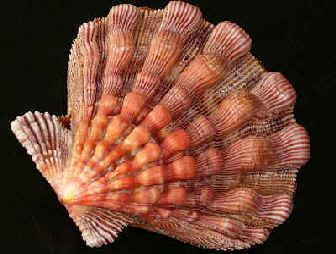
Above & below: the Lion's Paw Scallop
Below as it appears in the sea.
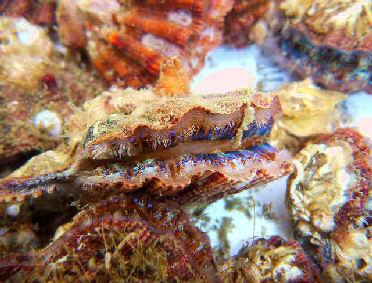
- Atlantic Deep-sea Scallop
______ NC VA (ASC:356) (PAS:26) (PS:22) Labrador
to Cape Cod, locally south to North Carolina in deeper water
Placopecten
magellanicus
- Rough Scallop
______ FL NC (PS:22) North Carolina to the West Indies
Aequipecten muscosus
- Spathate Scallop
______ DE FL MD NC VA
(PS:24) Cape Cod to the West Indies
Cryptopecten phrygium
FILE SHELLS
- Antillean File Shell ______
FL NC
(ASC:325) North Carolina to the West Indies
Lima pellucida
- Rough File Shell ______ FL
(ASC:350) off South Carolina to Brazil
Lima scabra
- Small-eared File
Shell ______ DE FL MD NC VA
Greenland to the West Indies
Limatula subauriculata
JINGLE SHELLS
- Prickly Jingle Shell ______
Labrador to Cape Cod, rarely south to Long Island
Anomia squamula
(or Anomia aculeata)
North of Cape Cod,
Anomia squamula (or aculeata) generally
replaces Anomia
simplex (below)
The Prickly Jingle Shell was
described by Linnaeus in 1758.
- Common Jingle Shell ______ DE FL MD
NC VA
(ASC:345) (PAS:24) (PS:25) Cape Cod to the Caribbean
Anomia simplex
In days gone by, an old name for Common Jingle Shells was "Mermaid's
Toenails".
The following is a beachcomer's poem about JINGLE SHELLS:
We collect the JINGLE SHELLS so numberous
By means of ulna, radius, and humerus,
And bring them to creative dreamers
On tired tubias and fibulas and femurs.
OYSTERS
- Atlantic Thorny Oyster ______
FL NC (ASC:349) (PS:25)
off North Carolina to Brazil
Spondylus americanus
- Eastern Oyster ______
FL MD
NC VA
(ASC:289) (PAS:32) (PS:25) Cape Cod to Gulf of Mexico, locally
north to Gulf of St. Lawrence
Crassostrea virginica
The common edible oyster of the eastern seaboard of North America,
the Eastern Oyster, Crassostrea virginica, has been popular as food
and heavily harvested . Its total range is in Atlantic coastal waters from
Canada to Argentina.
Crassostrea virginica has been
called the Common Atlantic Oyster.
At its peak, the oyster catch (of Crassostera virginica) in
the US state of Maryland was the largest in the world, yielding 15
million bushels a year.
The catch had declined by the mid-1980s to about 1 million bushels a year,
when a pair of parasitic diseases, MSX and Dermo, ravaged oyster beds and
drove the harvest down even more.
The harvest during the season from October 2010 to March 2011 was 121,173
bushels.
Since 1980, watermen in Maryland have taken about 25 per cent of the
remaining oysters every year. Scientists say that rate continues to reduce
the population.
A scientific study in August 2011 indicates that the ecologically important
bivalves in Maryland are even more depleted than previously believed,
and that continuing to catch them risks the elimination of them altogether
in much of the upper Chesapeake Bay.
Having said all this, Eastern Oysters are prolific. Each female
routinely spawns 10 to 20 million eggs. Large oysters may spawn up to
100 million.
An oyster may change its sex several times in successive seasons, but
larger ones are generally functional females. A large oyster may spawn
several times in one year.
Not all Oysters have the same shape.
Pacific Oysters are oval. European
Oysters are flat and round.
American oysters, from the
Eastern Seaboard of the US, Crassostrea virginica, are similar but
with a slightly more elongated shape.
With a powerful muscle that holds the shell shut, oysters filter
nutrients from the vast quantity of seawater they take in daily, and they
can be difficult to open.
Some oyster varieties, notably Pacific Oysters, are farmed
extensively. Oysters must be harvested from purified or unpolluted
water once landed, to ensure that they are safe to eat.
Oysters are available live in the shell, canned in brine, and smoked.
Live oysters should be kept chilled and lightly covered, with the
flat shell uppermost to prevent loss of the salty liquor.
There are various methods for opening oysters. If prying (or prising)
them, open with a knife. A proper oyster knife is the safest option because
a more flexible blade can snap and cause injury. If they are to be cooked,
they can be put into a very hot oven for a few moments until they open.
The whorls on the shells and, more importantly, the flavor of oysters
greatly depends on their diet. Flavors can be sweet, metallic, grassy, or
nutty.
The texture of a raw oyster varies by type and season, ranging from
soft and creamy to firm and meaty. During the summer they become milky and
soft. Hence, the expression that oysters are best "during the months with
a letter r".
Oysters are often served simply with a squeeze of lemon
juice.
- Crested Oyster ______ FL
NC VA (PS:25) Virginia to Brazil
Ostreola equestris
- Coon Oyster ______ FL NC
(ASC:359) (PS:25) North Carolina to the West Indies
Dendrostrea frons
The Coon Oyster was described by Linnaeus in 1758.
Raccoons like to feed on Coon Oysters, hence their common
name.
- Sponge Oyster
______ FL NC (PS:25) North Carolina to the West Indies
Cryptostrea permollis
CLAMS (including
COCKLES)
- Boreal Astarte ______ (ASC:341)
(PS:26) circumpolar, in the western Atlantic from
Greenland to Massachusetts
Astarte borealis
Astarte
was the Phoenician goddess of love. Astarte
borealis is also called the Northern Astarte.
- Elliptical Astarte ______
(PS:26) Greenland to Massachusetts
Astarte elliptica
- Chestnut Astarte ______
(PAS:25) (PS:26) Nova Scotia to New Jersey (around Ocean
City)
Astarte castanea
- Lentil Astarte ______ DE
FL MD NC VA
(PS:26) Labrador to Florida
Astarte subaequilatera
- Wavy Astarte ______ DE MD
(ASC:340) (PS:26) Labrador to Maryland
Astarte undata
- Carolina Marsh Clam ______
FL NC VA
(ASC:337) (PAS:28) (PS:27) Virginia to Texas
Polymesoda caroliniana
- Black Clam (ph) ______
(ASC:339) (PAS:28) (PS:27) from the Arctic Ocean to Cape Cod, further south
in deeper water to North Carolina
Arctica
islandica
Arctica islandica
is also called Ocean Quahog. The
species was described by Linnaeus in 1767.
A key characteristic of Arctica
islandica is its amazing lifespan. Scientists at Bangor
University have recently found a specimen that lived for more than 500
years, making the species the longest-lived non-colonial animal so
far discovered.
As with trees, Arctica islandica
deposits annual bands in its shell and these can be used to determine its
age. From the bands, changes can be analyzed relating to sea temperatures
over the centuries, and because Arctica
islandica is apparently resistant to some common indictors of
ageing, it has the potential for research into that process in various forms
of life.
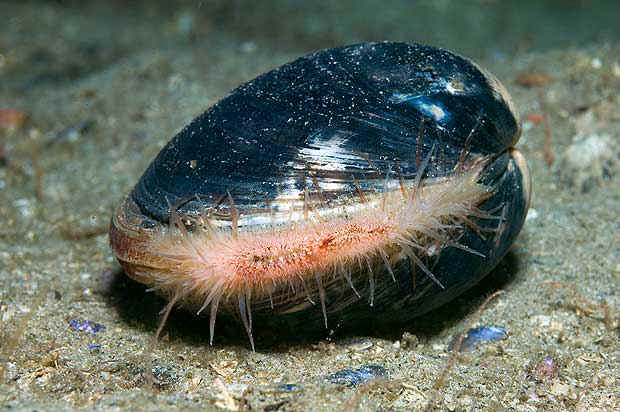
Above & below: Black Clam
In the lower photo, showing the black outside
and the white inside
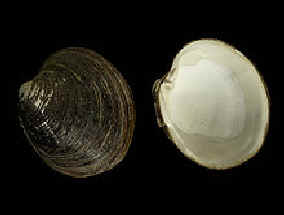
The Family VENERIDAE are the Venus Clams. In that large family are the
genera below, Macrocallista and Mercenaria.
- Sunray Venus ______ FL NC
(ASC:302) (PS:31) North Carolina to Florida
Macrocallista nimbosa
- Calico Clam
______ FL NC (PS:31)
North Carolina to Brazil, also Bermuda
Macrocallista maculata
The Calico Clam was described by Linnaeus in 1758.
-
Queen Venus ______ FL NC North
Carolina to the West Indies
Ventricolaria rugatina
- Cross-barred Venus
______ FL NC (PS:30)
North Carolina to the West Indies
Chione cancellata
The Cross-barred Venus was described by Linnaeus in 1767.
- Lady-in-waiting
Venus ______ FL NC (PS:24) North Carolina to the West
Indies
Chione intapurpurea
- Imperial Venus
______ FL NC (PS:30) North Carolina to the West Indies
Chione latilirata
- Gray Pygmy Venus
______ FL NC (PS:23)
North Carolina to Florida
Chione grus
- Empress Venus
______ FL (PS:30) South Carolina to Brazil
Circomphalus strigillinus
-
Glory-of-the-Seas Venus ______ FL NC
(PS:31) North Carolina to Brazil
Callista eucymata
- Atlantic Cyclinella
______ FL NC (PS:30) North Carolina to the West Indies
Cyclinella tenuis
- Stimpson's Transennella
______ FL NC North Carolina to Florida and the Bahamas
Transennella stimpsoni
- Waxy Gould Clam
______ FL NC (PS:23)
North Carolina to the West Indies, also
Bermuda
Gouldia cerina
- Hard-shelled Clam (or
Northern Quahog) ______ DE
FL MD
NC VA (ASC:338) (PAS:28) (PS:30)
from the Gulf of St. Lawrence to Florida
Mercenaria mercenaria
North of the range given above, the Quahog, as it is called in
New England, occurs less commonly and locally north to Maine, and then more
so in the Gulf of St. Lawrence.
Commercial names for Mercenaria mercenaria
are based upon size:
The Littleneck Clam is up to about 1 and a half inches.
The Cherrystone Clam is up to about 2 inches.
The Chowder Clam is up to about 3 inches or more.
Mercenaria mercenaria grows quickly,
but may live up to 25 years.
The species was described by Linnaeus in 1758. The word
"Mercenaria" comes from the shell's use in making
Indian money or wampum.
- Southern Quahog ______ MD
NC VA (ASC:336) (PS:30)
from the Chesapeake Bay and off New Jersey to Florida
Mercenaria campechiensis
Mercenaria campechiensis is larger
than Mercenaria mercenaria (above),
and it is rarely purple-stained.
Hybrids between the two species are common. Variants are difficult to
distinguish.
In addition to the range given above, the Southern Quahog also
occurs along the coast of the Gulf of Mexico, and in Cuba and the Yucatan
Peninsula of Mexico.
- False Quahog ______
DE MD NC VA (PS:31)
Prince Edward Island,
Canada to North
Carolina
Pitar morrhuana
Pitar morrhuana is like a small Quahog, growing up to only 2
inches long.
- Lightning Venus ______ FL
NC (PS:31) North Carolina to Brazil, also Bermuda
Pitar fulminatus
- Gibbs' Clam ______ FL NC
(PS:27) North Carolina to the West Indies
Eucrassatella speciosa
- Amethyst Gem Clam (or
Gem Shell) ______ DE FL MD
NC VA
(PAS:25) Nova Scotia to Texas
Gemma gemma
As are the clams in Macrocallista
and Mercenaria, Gemma gemma (above)
and those that follow in the genera Dosinia and
Liocyma are in
the family VENERIDAE, the Venus Clams.
- Disk Dosinia (or Disk Shell)
______ FL NC VA (ASC:334) (PAS:25) (PS:31)
Virginia to Gulf of
Mexico
Dosinia discus
- Elegant Dosinia ______ FL
NC (PS:31) North Carolina to Gulf of Mexico
Dosinia elegans
- Wavy Clam ______
(PS:24) Greenland to Maine
Liocyma fluctuosa

CLAMS have a
round, meaty body with a small amount of roe, and they come in a myriad of
sizes and colors.
Clams as seafood are usually sold live because they
deteriorate rapidly after death. Some, however, are cooked, extracted from
the shell and canned in brine or juice or packed in vinegar.
When obtained live, clams should either be cooked immediately or
stored briefly in a refrigerator. Water should not be added as it would kill
them.
To prepare clams, they should be rinsed thoroughly under cold,
running water to remove as much grit as possible. The shells should be
closed, or close immediately when sharply tapped. Any that either remain
open or have cracked or damaged shells should be discarded.
Clams can be eaten raw if they are properly treated when
harvested or if they come from very clean water.
After shucking, they can be served with a sauce or lemon juice.
Clams are often steamed in a small quantity of liquid, such as
stock, wine, or water, for 2 to 3 minutes, or until the shell has opened
completely. If cooked too long, they become tough.
They may be eaten straight from the shell or removed to be with sauces or
salads.
The cooking liquid is a flavorsome addition to calm dishes, but should be
filtered through a strainer to remove any traces of grit.
In the eastern US, clam chowders of various kinds, are
popular.

- Soft-shelled Clam ______ DE MD NC VA
(ASC:316) (PAS:28) (PS:38) from the Subarctic to Cape
Hatteras, NC
Mya arenaroa
The Soft-shelled Clam was described by Linnaeus in 1758.
Other names for Mya arenaroa
are Steamer Clam, Long Neck Clam, Long Clam, Gaper, and Nannynose.
All of these are names of the clam south of Cape Cod.
In New England, where it is simply called "The Clam", it is
usually fried.
Persistent clamming has made specimens of Soft-shelled Clams as large
as 6 inches rare and difficult to find.
- Truncate Soft-shelled Clam
______ (PS:38) Greenland to Massachusetts
Mya truncata
The Truncate Soft-shelled Clam was described by Linnaeus in 1758.
- Ovate Paramya ______ FL
NC North Carolina to Florida
Paramya subovata
- Atlantic Cleft Clam
______ DE FL MD NC VA
Nova Scotia to the West Indies
Thyasira trisinuata
LUCINES
- Pennsylvania Lucine
______ FL NC (PS:28) North Carolina to the West Indies
Lucina pensylvanica
The Pennsylvania Lucine was described by Linnaeus in 1758.
- Decorated Lucine ______
FL NC
North Carolina to Brazil
Lucina amiantus
- Four-ribbed Lucine ______
FL NC North Carolina to the West Indies
Lucina leucocyma
- Atlantic Lucine ______ MD
(PS:27) Maryland (described in 1936)
Lucinoma atlantis
- Northern Lucine ______ DE
FL MD NC VA (PS:27) Newfoundland to Florida
Lucinoma filosus
- Many-line Lucine ______ FL NC
North Carolina to Florida, also Brazil
Parvilucina multilineata
- Woven Lucine ______ FL NC
(PS:24) North Carolina to Florida
Phacoides nassula
- Thick Lucine ______
FL NC (PS:27) North Carolina to the West Indies
Phacoides pectinatus
- Buttercup Lucine ______ FL NC
(ASC:333)
(PS:28) North Carolina to the West Indies
Anodontia alba
- Chalky Buttercup
______ FL NC (PS:28)
North Carolina to the West Indies, also
Bermuda
Anodontia philippiana
- Costate Lucine
______ FL NC (PS:28)
North Carolina to the West Indies
Codakia costata
- Dwarf Tiger
______ FL NC (PS:28)
North Carolina to the West Indies
Codakia orbiculata
- Cross-hatched Lucine ______
DE FL MD NC VA (ASC:331)
(PAS:25) (PS:28) Cape Cod to Brazil
Divaricella
quadrisulcata
- Lunate Crassinella
______ DE FL MD NC VA
Massachusetts to Brazil
Crassinella lunulata (was Gouldia mactracea)
- Domingo Cardita
______ (PS:24) southeast US and the West Indies, offshore
Glans dominguensis
- Northern Cardita
______ (PAS:26) (PS:27) from
the Arctic Ocean to Cape Cod, occasionally south to Cape Hatteras
Cyclocardia borealis
- Flat Cardita
______ FL NC North Carolina to Florida
Pteromeris perplana
- Three-toothed Cardita
______ FL NC (PS:24)
North Carolina to Florida
Pleuromeris tridentata
- Atlantic Diplodon
______ FL NC (PS:24)
North Carolina to the West Indies, also
Bermuda
Diplodonta punctata
- Verrill's Diplodon
______ DE MD NC VA (PS:27)
Massachusetts to North Carolina
Diplodonta verrilli
- Florida Marsh Clam
______ FL (PS:27) Georgia and Florida
Cyrenoida floridana
- Corrugated Jewel
Box ______ FL NC (PS:28)
North Carolina to the West
Indies, also Bermuda
Chama congregata
- Leafy Jewel Box (ph)
______ FL NC (ASC:347) (PS:28) North
Carolina to the West Indies
Chama macerophylla
- Spiny Jewel Box ______ FL
NC (ASC;348)
(PS:29) North Carolina to Florida
Arcinella cornuta
Arcinella cornuta
is also called the Florida Spiny Jewel Box.
- Atlantic Strawberry Cockle
______ FL NC (ASC:362) (PS:29) Cape
Hatteras to the West Indies
Americardia media
The Atlantic Strawberry Cockle was described by Linnaeus in 1758.
- Iceland Cockle (ph) ______
(PS:29) from Greenland and Iceland to Massachusetts
Climcardium ciliatum
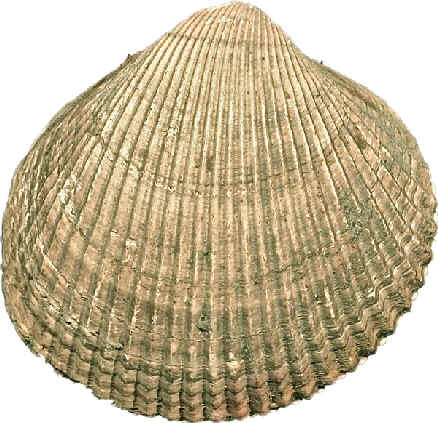
Iceland Cockle
- Greenland Cockle ______
(PAS:28) (PS:29) Greenland to Cape Cod
Serripes groenlandicus
- Giant Atlantic Cockle ______ FL
NC VA
(ASC:366) (PAS:26) (PS:5,29) Cape Henry, VA to Florida and the
Gulf of Mexico
Dinocardium robustum
Dinocardium robustum robustum ______ subspecies from Virginia to
northern Florida
The Giant Atlantic Cockle is a common beach shell southward.
Another name for it is Giant Heart Cockle.
- Common Egg Cockle ______ FL NC
(ASC:330)
(PS:29) North Carolina to the West Indies
Laevicardium
laevigatum
The Common Egg Cockle was described by Linnaeus in 1758.
- Morton's Egg Cockle ______
DE FL MD NC VA (ASC:342)
(PAS:25) (PS:24) Cape Cod to Brazil, locally north to
Nova Scotia
Laevicardium mortoni
- Florida Prickly
Cockle ______ FL MD (PS:29) North Carolina to Florida
Trachycardium egmontianum
- Yellow Cockle ______ FL
NC (ASC:363)
(PS:29) North Carolina to Brazil
Trachycardium
muricatum
The Yellow Cockle was described by Linnaeus in 1758.
- Spiny Paper Cockle
______ FL NC
(PS:29) North Carolina to the West Indies
Papyridea soleniformis
- False Angel Wing ______ DE FL MD NC VA
(ASC:297)
(PS:30) Prince Edward Island to Gulf of Mexico
Petricola
pholadiformis
- Atlantic Rupellaria
______ FL NC North Carolina to the West Indies
Rupellaria typica
- Coral-boring Clam ______ FL
NC (PS:27) North Carolina to the West Indies, also
Bermuda
Coralliophaga coralliophaga
- Smooth Duck Clam ______
FL NC North Carolina to Florida and Texas
Labiosa anatina
- Channeled Duck Clam ______ FL
NC (PAS:28) (PS:32) North Carolina
to the West Indies
Labiosa plicatella
- Arctic Wedge Clam ______
(PAS:28) (PS:32) Gulf of St. Lawrence to Long Island
and New Jersey
Mesodesma arctatum
- Turton's Wedge
Clam ______ (PS:32) Gulf of St. Lawrence, Canada
Mesodesma deauratum
TELLINS
- Northern Dwarf Tellin ______
DE MD NC VA
(ASC:326) (PAS:25) (PS34) Gulf of St. Lawrence to North Carolina
Tellina agilis
- Boss's Dwarf Tellin
______ FL NC
(PS:34) North Carolina to West Indies
Tellina probina
- Alternate Tellin ______ FL
NC (PS:33)
North Carolina to Gulf of Mexico
Tellina alternata
- Crystal Tellin
______ FL (PS:34)
South Carolina to the West Indies
Tellina cristallina
- Iris Tellin
______ FL NC
(PS:34) North Carolina to Florida and Texas
Tellina iris
- Rose Petal Tellin
______ FL NC
(PS:35) North Carolina to the West Indies
Tellina lineata
- Speckled Tellin
______ FL NC (PS:33)
North Carolina to Brazil, also Bermuda
Tellina listeri
- Great Tellin
______ FL NC (PS:33)
North Carolina to the West Indies
Tellina magna
- Lintea Tellin
______ FL NC
(PS:34,37) North Carolina to the West Indies
Tellina aequistriata
- Faust Tellin
______ FL NC
(PS:33) North Carolina to the West Indies
Arcopagia fausta
- Crested Tellin
______ FL NC
(PS:35) North Carolina to Florida and Texas
Tellidora cristata
MACOMAS
- Balthic Macoma ______ DE
MD NC VA
(ASC:343) (PAS:25) (PS:33) from the Arctic to Georgia
Macoma balthica
The Balthic Macoma was
described by Linnaeus in 1758. It is a
principal food of the American Black Duck.
- Short Macoma ______
FL South
Carolina to Brazil
Macoma brevifrons
- Chalky Macoma ______
(PS:33) Greenland to Long Island, NY
Macoma calcarea
- Narrowed Macoma ______
DE FL MD NC VA (PS:35)
Prince Edward Island, Canada to the West Indies
Macoma tenta
- Mitchell's Macoma ______
FL South Carolina to Texas
Macoma mitchelli
BEAN CLAMS
- Coquina ______ DE
MD NC VA
(ASC:321) (PAS:25) (PS:37) Virginia, rarely
Delaware, to the Gulf of Mexico
Donax variabilis
Other popular names for Donax variabilis
are Butterfly Shell, Wedge Shell, and Pompano.
Donax variabilis burrows in loose
sand at the midwater line, where in favorable conditions individuals may be
gathered by the handful with hardly any sand mixed in.
Even though the shells are so small (three-fourths of an inch long,
three-eighths of an inch high), they are often so gathered, and made
into a delicious broth.
Dead Coquina shells usually remain in pairs, connected at the hinge,
and spread out appearing like butterflies.
The color patterns of Donax variabilis
are variable - in fact quite so. Out of let's say 50 shells, it is sometimes
difficult to find 2 that are exactly alike.
- Fossor Coquina
______ Long Island, NY to New Jersey
Donax fossor
Donax fossor parvula ______ Poor Little Coquina
FL NC North Carolina to northern Florida
GARI SHELLS
- Purplish Targelus
______ DE FL MD NC VA (PS:36)
Cape Cod to the West Indies, also
Bermuda
Targelus divisus
-
Stout Tagelus ______ DE FL
MD NC VA (ASC:305)
(PAS:24) (PS:36) Cape Cod to Brazil
Tagelus plebeius
(formerly T. gibbus)
Tagelus plebeius is also called the Jackknife Clam.
RAZOR
CLAMS (other
than Solecurtus,
in the family Solenidae)
- Currugated Razor
Clam ______ FL NC
(PS:36) North Carolina to Brazil
Solecurtus cuminginus
- Little Green Razor
Clams ______ DE FL MD
NC VA (PS:38)
Rhode Island to northern
Florida and the northern Gulf of Mexico
Solen viridis
- Atlantic Razor Clam ______ DE
MD NC VA (ASC:304)
(PS:36) Gulf of St. Lawrence to North Carolina
Siliqua costata
- Scale Razor Clam
______ (PS:36) Newfoundland to Cape Cod
Siliqua squama
- Common Razor Clam ______ DE
FL MD NC VA (ASC:308) (PAS:24) (PS:38) Labrador to
Georgia, less so to Florida
Ensis directus
SURF CLAMS
- Fragile Surf Clam ______ FL
NC (PS:32) North Carolina to the West Indies
Mactra fragilis
- Surf Clam ______ DE
MD NC VA
(ASC:319) (PAS:28) Nova Scotia to South Carolina
Spisula solidissima
- Stimpson's Surf
Clam ______ (PS:32) Greenland to Rhode Island
Spisula polynyma
- Little Surf Clam
______ DE FL MD NC VA
(PS:24) Maine to Florida and Texas
Mulinia lateralis
- Wedge Rangia ______
MD NC VA (PAS:28) (PS:36)
Maryland to Texas and Mexico
Rangia cuneata
Rangia cuneata
is also called Common Rangia.
- White Strigilla
______ FL NC
(PS:35) North Carolina to the West Indies, also
Bermuda
Strigilla mirabilis
- Cancellate Semele
______ FL NC (PS:35)
North Carolina to Brazil, also Bermuda
Semele bellastriata
- White Atlantic Semele
______ FL NC
(PS:36) North Carolina to Brazil, also Bermuda
Semele proficna
- Purple Semele
______ FL NC
(PS:35) North Carolina to the West Indies
Semele purpurascens
- Common Cumingia
______ DE FL MD NC VA
(PS:35) Nova Scotia to Florida
Cumingia tellinoides
- Common Atlantic Abra
______ FL NC
(PS:35) North Carolina to Brazil
Abra aequalis
- Dall's Little Abra
______ DE FL MD NC VA
(PS:31) Cape Cod to the West Indies
Albra lioica
ROCK BORERS
- Arctic Rock Borer ______
DE FL MD NC VA (ASC:306) (PAS:27) (PS:36) from the
Arctic to the West Indies
Hiatella arctica
Another name for Hiatella arctica is Red Nose. The species was
described by Linnaeus in 1767.
The shell of Hiatella arctica is quite common as a fossil in northeastern
North America in Pleistocene rocks.
- Propeller Clam
______ (PS:36) Labrador to Rhode Island
Cyrtodaria siliqua
- Arctic Rough Clam ______
(PS:38) circumpolar, in the western North Atlantic from the
Arctic Ocean to Georges Bank
Panomya arctica
- Atlantic Geoduck
______ FL NC (PS:38)
North Carolina to Florida
Panopea bitruncata
CORBULA CLAMS
- Contracted Corbula ______ DE
FL MD NC VA
(PAS:25) (PS:23) Cape Cod to the West Indies
Corbula contracta
Another name for Corbula contracta is Common Basket Clam.
- Snub-nosed Corbula ______ FL
NC North Carolina to the West Indies
Corbula chittyana
- Dietz's Corbula ______ FL
NC
(PS:23) North Carolina to Brazil
Corbula dietziana
- Swift's Corbula ______ DE
FL MD NC VA Massachusetts to the West Indies
Corbula swiftiana
- Barratt's Corbula ______
FL NC North Carolina to Brazil
Corbula barrattiana
- Oval Corbula ______
FL NC (PS:33) North Carolina to the West Indies
Varicorbula operculata (has been Corbula disparilis)
GAPING CLAM
- Atlantic Rocellaria
______ FL NC North Carolina to the West Indies
Gastrochaena hians (was in the genus Rocellaria)
PIDDOCKS
- Angel Wing ______ FL
NC VA
(ASC:296) (PAS:27) (PS:38) Cape Cod to Brazil,
but rare north of Virginia
Cyrtopleura costata
Cyrtopleura costata
was described by Linnaeus in 1758. it belongs to a family of
borers, the PHOLADS.
When cleaned, the two delicate and graceful valves held together by the
hinge ligament truly suggest the wings of an angel.
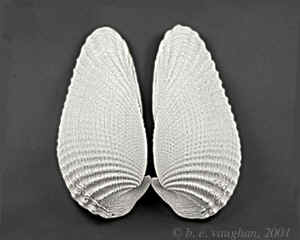
Angel Wing
- Fallen Angel Wing
______ DE FL MD NC VA
(PS:38) Massachusetts to Brazil
Barnea truncata
- Campeche Angel
Wing ______ FL NC
(PS:38) North Carolina to Brazil
Pholas campechiensis
- Wood Piddock ______ FL
NC (PS:38) North Carolina to Brazil
Martesia cuneiformis
These Martesia species (above
& below) occur from Cape Hatteras to Brazil, but they are wood
borers and may be carried north in driftwood.
- Striated Wood Piddock ______ FL
NC (ASC:313)
(PS:38) North Carolina to Brazil
Martesia striata
The Striated Wood Piddock was described by Linnaeus in 1758.
- Great Piddock ______
(ASC:314) (PAS:27) (PS:5,38) Labrador to Long Island and
New Jersey
Zirfaea crispata
- Atlantic Wood
Borer ______ DE MD VA
Quebec to Virginia
Xylophaga atlantica
SHIPWORMS
- Common Shipworm ______ DE
FL MD NC VA (ASC:311)
(PAS:27) the entire Atlantic Coast (of North America),
mostly south of Massachusetts
Teredo navalis
The Common Shipworm was described by Linnaeus in 1758.
- Gould's Shipworm
______ DE FL MD NC VA
New Jersey to Brazil
Bankia gouldi
PAPER SHELLS (or
LYSONIAS)
- Sand Lyonsia
______ (PS:23) Greenland to Maine
Lyonsia arenosa
- Pearly Lyonsia
______ FL NC (PS:37)
North Carolina to the West Indies
Lyonsia beana
- Glassy Lyonsia
______ DE MD NC VA
(PS:23,37) Nova Scotia to South Carolina
Lyonsia hyalina
PANDORAS
- Inornate Pandora
______ (PS:32) Nova Scotia to Massachusetts
Pandora inornata
- Glacial Pandora
______ (PS:32) from the Arctic to the Gulf of Maine
Pandora glacialis
- Sand Pandora
______ FL NC
(PS:37) North Carolina to Florida
Pandora arenosa
- Gould's Pandora
______ (PS:32) Gulf of St. Lawrence to New Jersey
Pandora gouldiana
- Three-lined
Pandora ______ FL NC
(PS:32) North Carolina to Florida and
Texas
Pandora trilineata
THRACIAS
- Conrad's Thracia
______ (PS:32) Nova Scotia to Long Island, NY
Thracia conradi
SPOON CLAMS
- Paper Spoon Clam ______
(PAS:23) Labrador to Rhode Island
Periploma
papyratium
- Lea's Spoon Clam ______ DE
MD NC VA
(PAS:23) (PS:32) Gulf of the St. Lawrence to North Carolina
Periploma
leanum
Periploma leanum is commonly
found washed ashore, but it lives subtidally in 15 ft. or more.
- Fragile Spoon Clam ______
(PS:32) Labrador to New Jersey
Periploma fragile
- Annular Spoon Clam ______ FL
(PS:32,37) Georgia to Texas
Periploma anguliferum
- Unequal Spoon Clam ______
FL South
Carolina to Texas
Periploma margaritaceum
DIPPER SHELLS
These small pear-shaped bivalves are called DIPPER SHELLS because of their
elongated handle-like posterior end (rostrum).
- Northern Dipper Shell
______ DE MD Nova Scotia to Maryland
Cuspidaria glacialis
- Rostrate Dipper Shell ______
(PS:37) in deep water, from the Arctic Ocean to the West Indies
Cuspidaria rostrata
- Costellate Dipper Shell ______
(PS:23) in deep water, off North Carolina to the West Indies
Cardiomya costellata
POROMYA CLAMS
- Granulate Poromya ______ in deep water, Maine to the West Indies
Poromya granulata
VERTICORDS
- Ornate Verticord ______
in deep water, Massachusetts to the West Indies
Verticordia ornata
SQUIDS
and OCTOPUSES (Class
Cephalopoda)
SQUIDS
- Common Spirula ______ DE
FL MD NC VA (PS:16)
worldwide, pelagic, shells washed ashore
Spirula spirula
The Common Spirula was described by Linnaeus in 1758.
- Fabricus Squid ______
in Arctic seas, along the North American Atlantic coast from Nova Scotia to
Rhode island
Gonatus fabricii
- Atlantic Long-finned Squid ______
DE MD NC VA
(ASC:486) (PAS:35) (PS:16) Nova Scotia to the Gulf of
Mexico, also Bermuda
Loligo pealei
Loligo pealei
is the most common squid between
Cape Cod and Cape Hatteras. It is abundant in shallow water during the
warmer months, April to November.
- Brief Squid ______ DE
FL MD NC VA (PAS:35)
Delaware Bay to Brazil, also Bermuda
Lolliguncula brevis
Lolliguncula brevis is also called Brief Thumbstall Squid.
- Short-finned Squid ______ (ASC:484)
(PAS:35) From the Arctic Ocean to northeast Florida
Illex illecebrosus
Another name for Illex
illecebrosus is Boreal Squid.
- Giant Squid ______
Architeuthis sp.
Giant Squids normally live
in the deep ocean out beyond the continental shelf. Occasionally, they have
washed ashore, or have been encountered at the surface of the sea all around
the North Atlantic, from Florida north to the Davis Strait, and east to
western Europe and the Madeira Islands.
Adults of Architeuthis are among
the largest invertebrates on the planet. They are said to reach a length of
60 feet or more with their tentacles extended. The mantle is one-fourth of
the total length.
OCTOPUSES
- Common Atlantic Octopus ______
(ASC:480) offshore from
Connecticut to Florida and
throughout the Caribbean; also Europe
Octopus vulgaris
Octopus vulgaris has an average arm length of 2 to 3 feet.
- Offshore Octopus ______
Bathypolypus arcticus
Bathypolypus arcticus is a rough
and warty species with a horn over each eye. It occurs along the entire
Atlantic coast (of North America) in deep water, but not as deep north of
Cape Cod.
PAPER
ARGONAUTS (Family Argonautidae)
- Paper Nautilus ______
(PAS:35)
(PS:74) worldwide, pelagic in warm seas
Argonauta argo (was Argonauta
americana)
Argonauta argo
is a deep-sea drifter. it
is best known by its elegant paper-thin shells that are washed ashore,
mainly on warmer Atlantic beaches and sometimes as far north as Cape Cod.
Another name for Argonauta argo is Common Paper Argonaut. it was described
by Linnaeus in 1758.
- Brown Paper Argonaut ______
(PS:74) worldwide, pelagic in warm seas
Argonauta hians
ARTHROPODS (including
Class Merostomata: with
the HORSESHOE CRAB and some extinct species)
- Horseshoe Crab (nt) (ph) (*) ______ DE
NC (ASC:666) (PAS:56) total
range from Maine to the Gulf of Mexico, many in the Delaware Bay
Limulus polyphemus
For Limulus
polyphemus, "Crab" is a misnomer. This
distinctive arthropod is more closely related to spiders and other arachnids
than it is to crustaceans.
The genus Limulus goes back a
long, long time, as far as the Triassic (the first period in the Age of
Dinosaurs).
It earliest ancestors lived in Devonian seas more than 350 million years
ago.
Today, the only living relatives of the Horseshoe Crab are found in
Asia, in Japan and India.
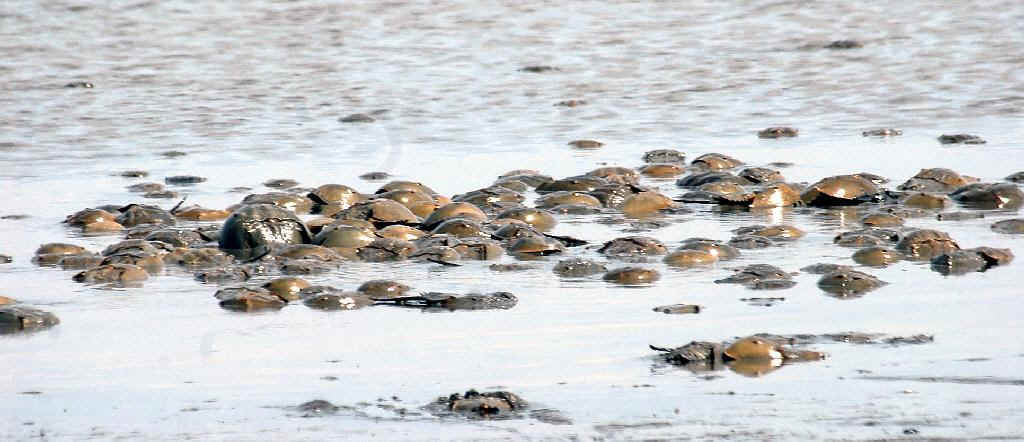
Above: a mass of Horseshoe Crabs on a tidal shoreline of eastern North
America
Below: a single Horseshoe Crab
(upper photo by Howard Eskin; lower photo by Rise Hill)
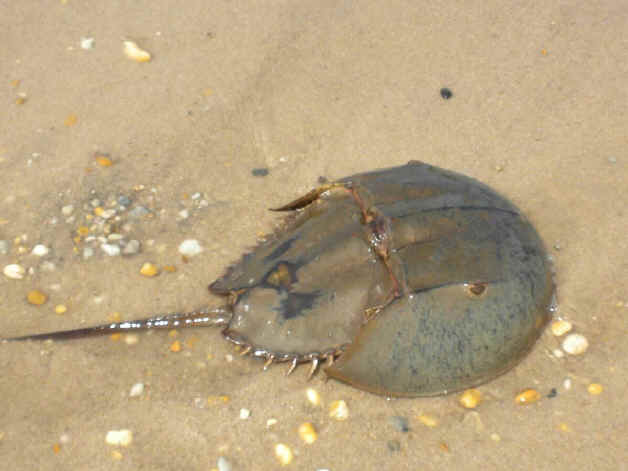
Below: every spring along the shores of the Delaware Bay,
millions of Horseshoe Crab eggs on the beach are food for
thousands of migrating shorebirds (and Laughing Gulls too).
Among the sandpipers each year, there are Red Knots, Dunlins,
Ruddy Turnstones, Sanderlings, and, as in the photo below,
Semipalmated Sandpipers. (photo
below by Howard Eskin)
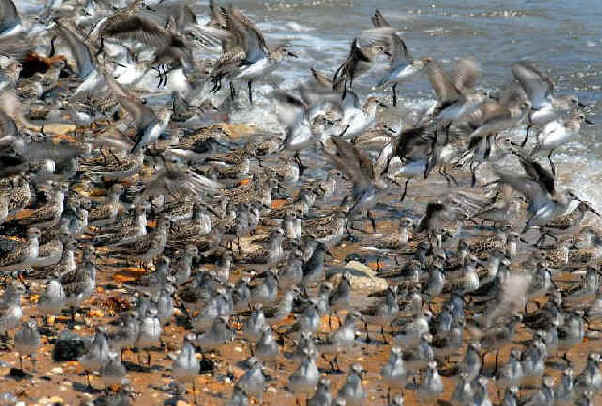
SEA
SPIDERS, or
PYCNOGONIDS (ARTHROPODS in Class Pycnogonida)
These creatures are only superficially spider-like. The bodies of
true spiders are distinctly 2-parted.
- Ringed Sea Spider ______ DE
FL MD NC VA
(ASC:578) (PAS:48) Bay of Fundy to Brazil
Tanystylum orbiculare
- Lentil Sea Spider ______ DE
FL MD NC VA (ASC:576)
(PAS:48) Bay of Fundy to the Caribbean
Anoplodactylus lentus
- Clawed Sea Spider ______ (ASC:575)
from the Arctic to Long Island Sound, common north of Cape Cod, also North
American Pacific coast
Phoxichilidium femoratum
- Long-necked Sea Spider ______ DE FL MD NC VA
(PAS:48) Cape Cod to Florida
Callipallene brevirostris
The body length of the Long-necked Sea Spider (even with its long
neck) is one-sixteenth of an inch.
It is a common shallow-water species on pilings.
- Anemone Sea Spider ______
(ASC:577) (PAS:48) Gulf of St. Lawrence to Long Island Sound
Pycnogonum littorale
Pycnogonum littorale (three-sixteenth
of an inch long) clings louse-like to large anemones.
- Sargassum Sea Spider
______ on pelagic
gulfweed only
Endeis spinosa
CRUSTACEANS
(Class Crustacea)
BARNACLES & allies
(including MANTIS SHRIMP,
ISOPODS, AMPHIPODS, BEACH FLEAS)
- Common Goose
Barnacle ______ DE FL MD
NC VA (ASC:288) (PAS:17)
found washed ashore along both Atlantic and Pacific coast of North America
Lepas anatifera
- Float Goose
Barnacle ______ DE FL MD
NC VA found washed ashore along both Atlantic
and Pacific coasts of North America
Lepas fascicularis
- Little Gray
Barnacle (*) ______ DE
FL MD NC VA (ASC:276)
(PAS:18) New Jersey to the Caribbean, locally north
to Cape Cod
Chthamalus fragilis
The Little Gray Barnacle is abundant from the Delaware Bay and
Chesapeake Bay south.
- Little Striped
Barnacle ______ DE FL MD
NC VA (ASC:279) from Cape
Cod to Texas, also in the West Indies, and along the Pacific coasts of North
and Central America
Balanus amphitrite
- Northern Rock
Barnacle ______ DE (ASC:278,286)
(PAS:18) along the north Atlantic Coast (of North America)
south to Delaware
Balanus balanoides
- Rough Barnacle
______ (ASC:285) from the Arctic to
Cape Cod
Balanus balanus
- Ivory Barnacle
______ DE FL MD NC VA (ASC:275) (PAS:18) Maine
to South America
Balanus eburneus
- Bay Barnacle
______ DE FL MD NC VA (ASC:274) Nova Scotia to
Brazil
Balanus improvisus
- Common Mantis
Shrimp ______ DE FL MD
NC VA (PAS:54,56)
Cape Cod to the Gulf of Mexico and south to Brazil
Squilla empusa
- Sea Pill Bug ______
DE FL MD NC VA (PAS:50)
Cape Cod to Florida
Sphaeroma quadridentatum
The Sea Pill Bug, a little white-splotched isopod, rolls into a
ball when disturbed.
- Bay Greedy Isopod ______
from the Bay of Fundy to Cape Cod MA
Cirolana polita
- Baltic Isopod
______ DE MD NC VA (ASC:585) (PAS:50) Gulf of
St. Lawrence to North Carolina
Idotea baltica
- Sharp-tailed Isopod
______ Gulf of St. Lawrence to Cape Cod
Idotea phosphorea
- Exotic Sea Roach
______ FL NC VA
(PAS:50) from the lower Chesapeake Bay to the Caribbean
Ligia exotica
- Northern Sea Roach
______ (ASC:580) from
Massachusetts northward to Maine
Ligia oceanica
- Red-eyed Amphipod
______ (ASC:589) Labrador to Long
Island Sound
Ampithoe rubricata
- Scud ______ DE
FL MD NC VA
(ASC:591,598) (PAS:51) along the entire Atlantic Coast (of
North America), in both salt and fresh water
Gammarus oceanicus
Another name for the Scud is "Sideswimmer".
- Mottled Tube-maker
______ DE FL MD NC VA (ASC:590)
Newfoundland to
Texas, also North American Pacific coast
Jassa falcata
- Noble Sand
Amphipod ______ (ASC:588) Labrador to Long Island Sound
Psammonyx nobilis
- Big-eyed Beach
Flea ______ DE FL MD
NC VA (ASC:587)
Newfoundland, Canada to
Florida
Talorchestia megalophthalma
These beach fleas
(above & below) are lively creatures that can leap a foot or more,
much like fleas.
Some bathers are unnecessarily apprehensive about being bitten by beach
fleas, but they feed only on organic debris.
- Long-horned Beach
Flea ______ DE FL MD
NC VA the same geographic range as the the previous
species
Talorchestia longicornis
SHRIMPS
and
LOBSTERS
SHRIMP (or PRAWNS) are highly sought after as seafood, and are
both caught in the wild and extensively farmed.
The word "shrimp" is inclusive of all varieties in the
United States, but in some other English-speaking countries it is used for
only a couple species.
Shrimp vary in color when alive, but most turn pink-orange when
cooked.
There are many environmental and sustainability issues with the harvesting
of wild shrimp and also some with the methods of farming them.
Shrimp are sold cooked or raw, whole or shelled, or, very
occasionally, live. They should be deveined as the gritty intestinal tract
can be unpleasant to eat.
Shrimp, or prawns, are very meaty, dense and sweet compared to
the more intense flavor and delicate textures of the cold water crustaceans.
They can be grilled (broiled) or pan-fried and served with lemon and olive
oil. They are better left unpeeled when grilled because they are less likely
then to dry out. Over-cooking makes them tough. The shells make excellent
stock that can be used in soup or
risotto.
- Linear Skeleton
Shrimp ______ DE FL MD
NC VA (ASC:601) (PAS:53)
entire Atlantic coast of North America
Caprella linearis
- Long-horn Skeleton
Shrimp ______ DE MD NC
VA (ASC:599) from
Labrador to North Carolina
Aeginella longicornis
- Opossum Shrimps
______ (ASC:604,606) from the Gulf
of St. Lawrence to New Jersey
Mysis spp.
- Red Opossum Shrimp
______ (ASC:603) from the Bay of
Fundy to New Jersey
Heteromysis formosa
- Bent Opossum
Shrimp ______ (ASC:602) Nova
Scotia, Canada to Cape Cod MA
Prannus flexuosus
The Bent Opossum Shrimp was first found in North American coastal waters in
1960 at Barnstable, Massachusetts (on Cape Cod).
It was presumably an introduced species from Europe, and it is now common in
the shallow waters of the Gulf of Maine as far north as Nova
Scotia.
- Horned Krill
______ DE FL MD NC VA
(ASC:605) the northern
Atlantic coast
Meganyctiphanes norvegica
KRILL is a collective name for several kinds of planktonic shrimps
that occur in large masses.
It is eaten by BALEEN WHALES, which charge, mouths wide open, into a school
of KRILL, and then, mouths closed, strain out the KRILL.
The HORNED KRILL (above) is sometimes so abundant that its
swarms cause the water to appear red.
- Brown Shrimp
______ DE FL MD NC VA (PAS:55,56) New
Jersey to Uruguay
Penaeus aztecus
- Pink Shrimp
______ FL NC VA (ASC:609,611) (PAS:55,56) Chesapeake Bay
to Brazil
Penaeus duorarum
- White Shrimp
______ DE FL MD NC VA (PAS:55,56) northern
limit is Long Island, NY
Penaeus setiferus
The above 3 species, in the genus Penaeus, are the backbone of the Atlantic
shrimping industry.
- Common Shore
Shrimp ______ DE FL MD
NC VA (ASC:607)
(PAS:55) from the Gaspe Peninsula, Quebec to the
Yucatan Peninsula in Mexico
Palaemonetes vulgaris
Palaemonetes vulgaris
prefers saltier water than others in its genus.
- Red-lined Cleaning
Shrimp ______ FL NC VA
(ASC:613) Chesapeake Bay to Brazil
Lysmata wurdemanni
- Greenland Shrimp
______ (ASC:612) from the Arctic to
Massachusetts
Lebbeus groenlandicus
- Maine Shrimp ______
(PAS:54,56) Circumpolar, south to Cape Cod, MA
Pandalus
borealis
- Montague's Shrimp
______ (ASC:614) (PAS:54,56) Circumpolar,
from the Arctic south to Rhode Island
Pandalus montagui
- Sand Shrimp
______ DE FL MD NC VA
(ASC:593) (PAS:54)
from the Arctic to Florida
Crangon septemspinosa
- Northern Lobster (ph)
______ (ASC:624) (PAS:56) Labrador
to New Jersey, very rarely to Virginia, especially common in Maine
Homarus americanus
The Northern Lobster has a length of about 25 inches (and up to 34
inches), and a mass of up to 44 pounds making it the heaviest crustacean in
the world. That 44.4 pound lobster was caught off Nova Scotia, Canada.
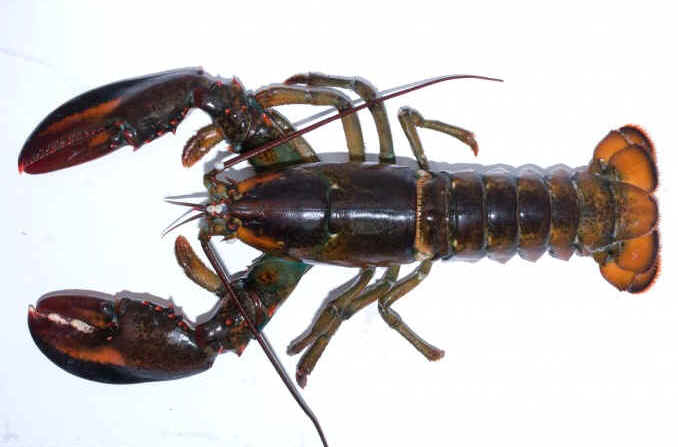
Above & below: the Northern Lobster
Below: a very young one
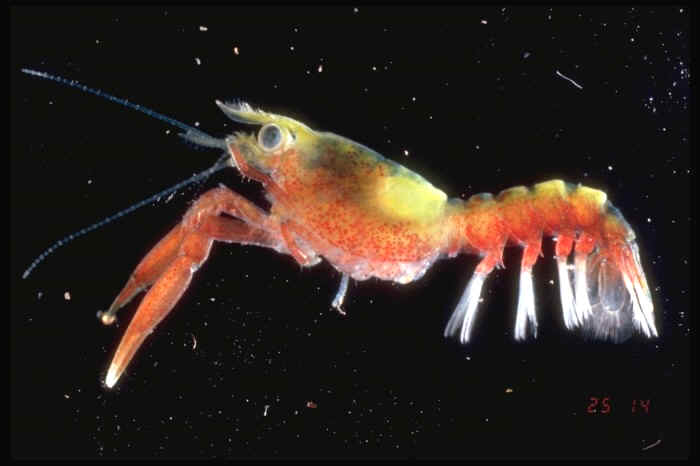
Actually, only a few of the
hundreds of different lobsters in the world are caught commercially for
food.
There are Rock Lobsters, Spiny Lobsters, Slipper Lobster, and Caribbean
Lobster, just to name a few of many. A couple of these are in this list
below.
The lobsters that many know on their dinner plates are the American
(often called Northern) and European clawed lobsters,
respectively Homerus americanus (above) and Homarus gammarus.
These are cold water species that live on each side of the North Atlantic
Ocean.
Some of the lobsters noted above are "tropical lobsters"
that are also widely consumed.
Including the Spiny and Slipper Lobsters, they are clawless.
Homarus americanus was not always thought of as it is now, as a fine
dish and delicacy. In 17th & 18th Century America, they were abundant in
northeastern North America, so much so that they were often used as
fertilizer.
Now, the clawed Homarus lobsters are said to be declining.
"Overfishing" has taken its toll, but during catches are better
than others.
Closely related to the genus Homarus is Nephrops, a genus now
with a single species in Europe, Nephrops norvegicus, known as the Norwegian
Lobster and other names including scampi, lobsterettes, and langoustine.
There were species of Nephrops in the Americas, now known only
by fossils: 2 species in the Dominican Republic from the Oligocene or
Miocene Periods, and one in Panama from the Pleistocene.
Another fossil species in Texas, Nephrops americanus, described in
1935, has been determined not to be similar to either Nephrops, or Metanephrops
that was once part of Nephrops.
Molecular phylogenetics suggests that Nephrops and Metanephrops
are not sister taxa, with instead Nephops being more closely related
to Homarus than either is to Metanephrops.
There is a species of Metanephrops in the western Atlantic region,
the Caribbean Lobster or Caribbean Lobsterette (below),
occurring in the Bahamas and southern Florida, and south to the Guianas
including the Gulf of Mexico and the Caribbean Sea.
Other species in the Metanephrops
genus are, among other places, in Japan, Australia, and New Zealand.
LANGOUSTINE (Nephrops
norvegicus) are coral in color and become paler upon cooking. Most of
its weight is made up of shell, with slender claws, tiny legs, and a long
carapace (head shell).
Langoustine is not commonly available in the United States, and it
can be replaced with large fresh shrimp (prawns) of crawfish.
The only edible part of langoustines is the tail, which is sweet,
succulent, and tender, not unlike a lobster.
Langoustines may be poached in a bouillon, roasted, or split in half,
brushed with butter or oil and grilled (broiled) to be enjoyed straight from
the shell, again much like a lobster.
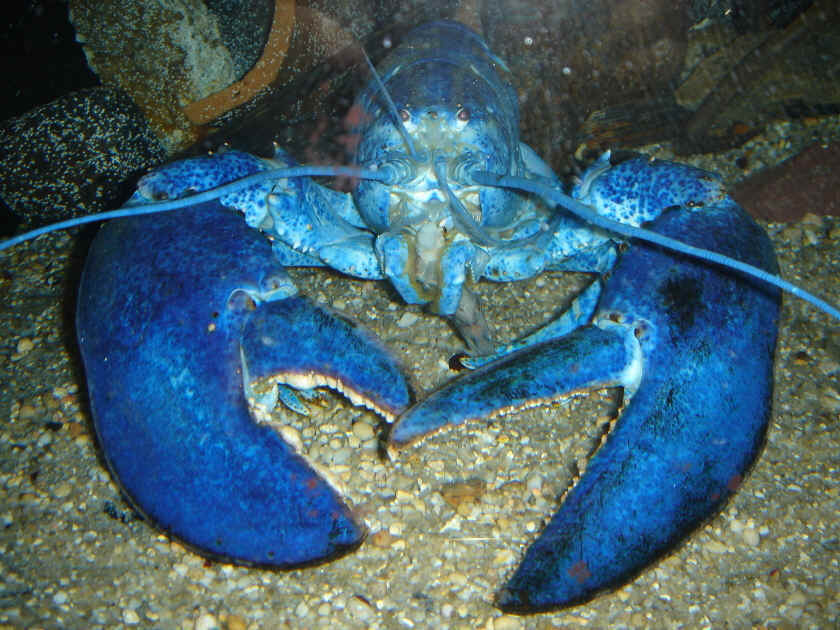
A "Blue
Lobster" of Homarus americanus
Northern Lobsters are red as
the usual result of being cooked. There is only a 1 in 10 million chance of
catching one alive that is red. The normal coloration of Homarus
americanus is a dark bluish-green to a bluish-brown.
Living Northern Lobsters can be yellow as a result of a rare
genetic mutation, with the odds of finding one estimated as 1 in 30 million.
Single yellow lobsters were found in Maine in the US in August
2006, in Prince Edward Island in June 2009, and in Rhode Island
in the US in July 2010.
There is also a form (as in the photo above) of the Northern Lobster that is blue.
For
that to happen, there's a genetic mutation that causes the lobster to
produce an excessive amount of a particular protein. That protein and a red
carotenoid molecule known as astaxanthin combine to form a blue complex
known as crustacyanin, giving the lobster its blue coloration.
A single blue lobster was caught in New Hampshire in the US in
2009, and in Canada 2 were caught off Prince Edward Island
in 2011, 1 off New Brunswick that year, and another off Nova
Scotia in May 2012.
- Caribbean Lobster
(or Caribbean Lobsterette) ______ FL
Metanephrops binghami
- West Indian Spiny
Lobster ______ FL NC (ASC:625)
North
Carolina to Brazil
Panulirus argas
Panulirus argas is called "crawfish" in many places, but it should
not be confused with the freshwater crawfish or crayfish.
- Ridged Slipper
Lobster ______ FL NC
North Carolina to the West Indies
Scyllarides nodifer
- Flat-browed Mud
Shrimp ______ DE FL MD
NC VA (ASC:621)
(PAS:57) Cape Cod MA to Brazil
Upogebia affinis
- Short-browed Mud
Shrimp ______ DE FL MD
NC VA (PAS:57)
Nova Scotia to Florida
Callianassa atlantica
CRABS
CRABS are found on every continent. An array of varieties of both small and
large crabs make them a favorite seafood many places throughout the world.
Little mud crabs are perfect for soups and stocks.
Dungeness Crabs (in western North America, along the coast of the Pacific
Northwest) provide wonderfully sweet meat.
Shore crabs in their molted state are a delicacy, and are known as
"soft-shell crabs".
And the magnificent King Crab (of Alaska) is favored for its leg meat.
Many crabs are harvested sustainably as they are caught live.
Generally, crab contains two types of meat:
White meat is extracted from the
legs, claws, and central body.
Brown meat is located in the carapace or shell that contains the main
organs.
White meat is generally the more popular because it is sweet and
delicate. Brown meat, or the meat from the body of the crab, has a
stronger and more pronounced flavor and varies in consistency.
Crab is sold live, cooked and unprepared, and cooked and dressed
(which means that the inedible parts have been removed).
Fresh, pasteurized and canned crab meat is also available, usually
separated into white and brown.
Cooked crab should always be purchased from a reliable source. It
should have a lovely sweet seafood aroma.
To remove the meat from a cooked crab, place it on its back and break
off the claws and legs, then break off the tail flap. Insert a heavy-bladed
knife between the body shell, twist and then pry apart with your thumbs.
Remove and discard the "dead man's fingers" (the gills).
Using a spoon, scoop the brown meat out into a bowl. Halve the body with a
sharp knife and carefully pick out the meat. Finally, press on the back
shell just behind the eyes, then remove and discard the mouth and stomach
sac. Scoop out the remaining brown meat.
Some notes, now, regarding the taxonomy of
"crabs".
The genera that follow are in a number of families:
In the families:
PORCELLANIDAE. the genera Porcellana and Euceramus, the
"'Porcelain Crabs"
DIOGENIDAE, the genera Petrochirus, Clibanarius, Dardanus, the
"Hermit Crabs"
PAGURIDAE, the genus Pagurus, a "Hermit Crab"
HIPPIDAE, the genus Emerita
DROMIIDE, the genus Dromidia
LEUCOSIIDAE, the genus Persephona
CALAPPIDAE, the genus Calappa, "Box Crabs"
AETHRIDAE, the genus Hepatus
PORTUNIDAE, the genera Ovalipes, Portunus, Callinectes, Carcinus, the
"Swimming Crabs"
CANERIDAE, the genus Cancer
ERIPHIIDAE, the genus Eriphia
PANOPEIDAE, the genera Eurypanopeus and Neopanope, the
"Mud Crabs"
MENIPPIDAE, the genus Menippe
GRAPSIDAE, the genera Pachygraspsus and Plagusia, the
"Shore Crabs"
VARUNIDAE, the genus
Hemigrapsus, also
"Shore Crabs"
SESARMIDAE, the genus Sesarma
OCYPODIDAE, the genera Ocypode and Uca, "Sand Crabs"
and "Fiddler Crabs"
OREGONIIDAE, the genus Hyas
EPIALTIDAE, the genus Libinia
MAJIDAE, the genus Mithrx
INACHIDAE, the genus Stenocianops, the "Arrow Crab"
PARTHENOPIDAE, the genus Parthenope
PORCELAIN CRABS
- Say's Porcelain Crab (ph)
______ FL NC (ASC:647)
Cape Hatteras NC to
Venezuela
Porcellana sayana
The Say's Porcelain Crab
is sometimes commensal with large hermit crabs, which are rather
messy eaters, shredding their food and dropping bits, which Porcellana
sayana then retrieves.
The Say's Porcelain Crab
is one half inch long & one half inch wide.
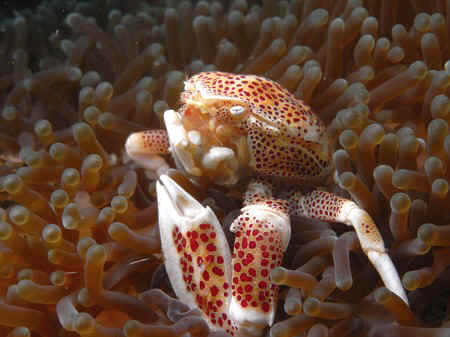
Say's Porcelain Crab
- Olive-pit Porcelain Crab ______
MD
Euceramus praelongus
HERMIT CRABS
- Giant Hermit Crab ______ FL
NC
(ASC:682) North Carolina to the West Indies
Petrochirus diogenes
At its common name implies, Petrochirus diogenes is the largest hermit crab
in North America.
- Striped Hermit Crab ______ FL
NC
(ASC:684) (PAS:57) North to North Carolina,
occasionally Virginia; south to Brazil
Clibanarius vittatus
- Star-eyed Hermit
Crab ______ FL NC (ASC:687)
North
Carolina to Brazil, also Bermuda
Dardanus venosus
- Acadian Hermit Crab ______ DE
MD (ASC:686) (PAS:57) Labrador
to the Chesapeake Bay
Pagurus acadianus
- Banded Hermit Crab ______ MD
Pagurus annulipes
- Hairy Hermit Crab
______ (ASC:681) (PAS:57) from
the Arctic south
to Long Island Sound
Pagurus arcuatus
- Long-clawed Hermit Crab ______ DE
FL MD
NC VA (ASC:677) (PAS:57)
Nova Scotia to the Gulf of Mexico
Pagurus longicarpus
Another name for Pagurus longicarpus
is Long-armed Hermit Crab.
The Long-clawed Hermit Crab is the most common hermit crab
along the Atlantic Coast. It normally uses the shells of the periwinkle,
mud snail, or oyster drill.
- Flat-clawed Hermit Crab ______ DE
FL MD
NC VA
(ASC:676) (PAS:57) generally Cape Cod to Texas
Pagurus pollicaris
The Flat-clawed Hermit Crab is often found in the shells of Moon
Snails and the larger whelks.
Pagurus pollicaris is pinkish. Its carapace is up to
1.25 inches in length.
KING CRAB
- Spiny Crab ______
(PAS:60) A Boreal deepwater crab
Lithodes maia
MOLE CRAB, SAND CRAB
- Atlantic Mole Crab ______ DE
FL MD NC VA (ASC:690) (PAS:55) Cape Cod to the Gulf of Mexico
Emerita talpoida
Another name for Emerita talpoida
is Atlantic Sand Crab.
SPONGE CRAB
- Lesser Sponge Crab ______ FL
NC
(ASC:669) Cape Hatteras NC to Brazil
Dromidia antillensis
PURSE CRAB
- Purse Crab ______ FL
NC (ASC:635) (PAS:60) North
Carolina, sometimes New Jersey, south to the Gulf of Mexico
Persephona punctata
The Purse Crab was described by Linnaeus in 1758.
BOX CRAB
- Flame-streaked Box Crab ______ FL
NC
(ASC:671) (PAS:58) North Carolina to Mexico, also Bermuda and
Bahamas
Calappa flammea
Another name for Calappa flammea
is Shame-faced Crab.
Calappa flammea
is less common than
Hepatus epheliticus
(below)
in a similar geographic range.
AETHRIDAE CRABS
- Calico Crab (ph) ______ FL
MD
NC VA (PAS:58)
generally from the Chesapeake Bay to Mexico; as a
stray north of Cape Hatteras; the young rarely to Cape Cod
Hepatus epheliticus
Other names for Hepatus epheliticus
are "Dolly Varden" and Calico Box Crab.
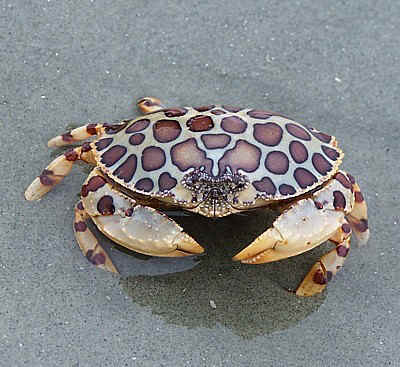
Calico Crab
SWIMMING CRABS
- Ocellate Lady Crab (ph) ______
DE FL MD NC VA
(ASC:637) (PAS:61) Cape Cod to the Gulf of Mexico
Ovalipes ocellatus
Other names for Ovalipes ocellatus
are Leopard Spotted Crab, or simply Lady Crab.
Outside the range noted above, there has been said to be an isolated
population of Ovalipes ocellatus at
Prince Edward Island, Canada.
Within the given range, it is in shallow water, mainly subtidal on sandy
bottoms, but to the waterline when the tide is in.
The attractive Ocellate Lady Crab is as quick and ill-tempered as the
Atlantic Blue Crab (later in this list).
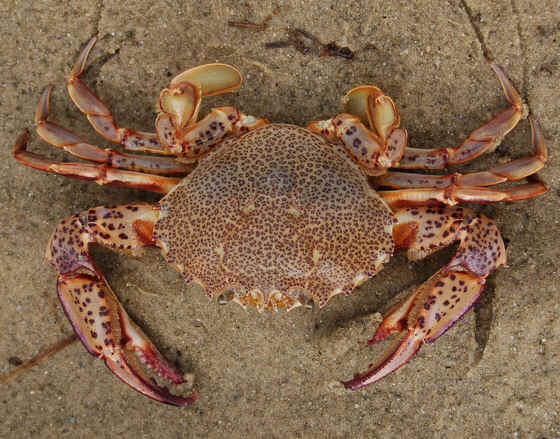
Ocellate Lady Crab
- Gibbes' Crab ______ DE
FL
MD NC VA Massachusetts to Venezuela
Portunus gibbesii
Another name for Portunus gibbesii is
Iridescent Swimming Crab.
- Spiny-banded Crab ______ DE
FL
MD NC VA New Jersey to Brazil, also Bermuda
Portunus spinimanus
Another name for Portunus spinimanus is
Blotched Swimming Crab.
- Sargassum Crab (ph) (*) _____
NC(pelagic)
(ASC:658)
Portunus sayi
The Sargassum Crab is normally a creature of the high
seas and a member of the Sargasso Weed community.
Although it resides out at sea, it is often seen among weeds blown
ashore by storms.
Portunus sayi has been among
the sealife in sargassum in the Gulf Stream during FONT North Carolina
pelagic trips.
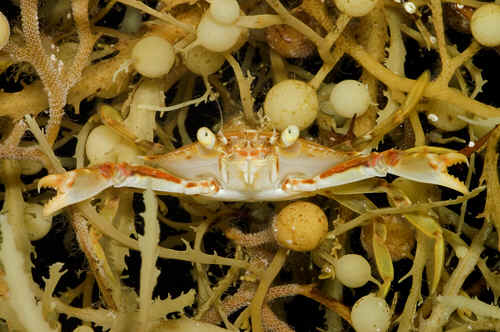
Sargassum Crab
- Flat-browed Crab
______ FL NC (ASC:633)
North Carolina to the West Indies and the Yucatan Peninsula, also Bermuda
and the Bahamas
Portunus depressifrons
- Gulfweed Crab ______ NC(pelagic)
(PAS:58) out at sea, on drifting Gulfweed (Sargassum)
Planes minutus
The scientific name, Planes minutus,
means "little wanderer". Columbus was said to have seen the
species in the mid-Atlantic.
- Atlantic Blue Crab (ph) (*) ______
DE FL MD
NC VA
(ASC:657) (PAS:61) Cape Cod to Uruguay
Callinectes sapidus
Except when soft, the Atlantic Blue Crab is quick and aggressive,
snapping viciously when caught. Even half-grown young can inflict painful
pinches.
Barnacles commonly attach themselves to Atlantic Blue Crabs,
especially in southern regions.
The Striped Barnacle and Turtle Barnacle do so externally.
A small goose barnacle, Octolasmus lowei,
goes in the gill chamber, and a bean-shaped sacculinid, Loxothylacus
texanus, goes under the abdomen.
A parasitic nemertean worm, Carcinonemertes
carcinophila, is found on the gills of female crabs. It is
pinkish on virgin crabs, and red on breeders.
- Lesser Blue Crab ______ DE
FL MD NC VA
from Cape May, NJ south
Callinectes similis
The Lesser Blue Crab is a common estuarine crab south of Cape
Hatteras, NC. It ranges into fresh water.
Callinectes similis is easily
mistaken for Callinectes sapidus (above).
- Green Crab
______ (ASC:664)
(PAS:61) Iceland and Nova Scotia to New Jersey (to
about Manasquan
Inlet)
Carcinus maenas
In addition to its natural geographic range above, the Green Crab has been
introduced in Brazil and Panama.
Originally, it was introduced into the Americas from Europe.
In the 19th Century, it was unknown north of Cape Cod MA. Now it is the most
common crab along the shores of the Gulf of Maine.
The Green Crab can easily be
confused with the Jonah Crab (below, the next crab in this list).
CANCER CRABS
- Jonah Crab
______ DE FL MD NC VA
(ASC:653)
Nova Scotia to Florida, also Bermuda
Cancer borealis
The Jonah Crab is usually
in deeper water than the Atlantic Rock Crab (below, the next crab
in this list).
- Atlantic Rock Crab
______ DE MD NC VA (ASC:650,654)
(PAS:61) Iceland and Labrador to South Carolina
Cancer irroratus
ERIPHIIDAE CRAB
- Warty Crab
______ FL NC North Carolina to Argentina
Eriphia gonagra
MUD CRAB
- Flat-backed Mud Crab
______ DE FL MD NC VA
(ASC:645) Massachusetts Bay to the West Indies, also Bermuda
Eurypanopeus depressus
Another name for Eurypanopeus depressus is
Flat Mud Crab.
- Say's Mud
Crab ______ DE FL MD
NC VA (ASC:636) Prince
Edward Island to Florida
Neopanope texana
From Virginia southward, the Say's Mud Crab lacks the black color on the
fingers of its pincers, and is larger than those further north.
ROCK CRABS, or
SPRAY CRABS
- Stone Crab (ph)
______ FL NC (ASC:642)
North Carolina to
the West Indies and the Yucatan
Menippe mercenaria
The Stone Crab is the
source of the delectable seafood dish, crab claws.
Its catch in most of the US is carefully regulated. In Florida, it is
illegal to take females.
When a male is taken, one may break off and keep the large pincer - if it is
at least 4 inches from tip to first point - but the crab must be
returned to the water for it to regenerate a new pincer.
Most crustaceans, including the Stone Crab, can regenerate an
appendage in 2 molts.
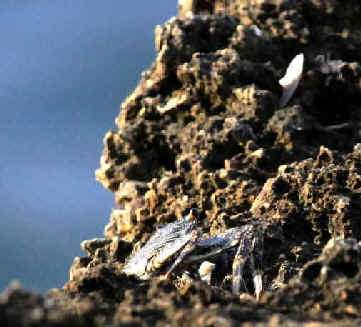
Blending in on a coastal rock, a Stone Crab,
photographed during a FONT tour in the West Indies.
(photo by Marie Gardner)
- Mottled Shore Crab
______ FL NC North Carolina to the West Indies, also Bermuda
Pachygrapsus transversus
- Flattened Crab
______ FL NC North Carolina to Brazil, also Bermuda
Plagusia depressa
SHORE CRAB: in the
family VARUNIDAE
- Asian Shore Crab ______ DE
MD NC VA not native to North America, now
along the Atlantic cost in the eastern US
Hemigrapsus
sanguineus
The native range of Hemigrapsus
sanguineus is along the Asian Pacific coast from Russia to
Hong Kong, including Japan.
The first record outside that range was at Townsend's Inlet in Cape May
County, New Jersey in 1988.
Since the 1990s, the invasive species has spread north into Maine and south
into North Carolina.
PEA CRABS
- Commensal Crabs
______ DE FL MD NC VA
(ASC:634) Massachusetts USA
to Argentina, also Pacific coast of the Americas
Pinnotheres spp.
SESARMIDAE CRABS
- Wharf Crab
______ FL MD NC VA
(ASC:665) Chesapeake Bay to the
West Indies and Venezuela
Sesarma cinereum
A nickname for Sesarma cinereum is
"Friendly Crab"
from its habit of climbing onto boats.
- Purple Marsh Crab ______ DE
FL MD NC VA
(PAS:58) locally, from
Cape Cod to Texas, intertidal
Sesarma reticulatum
Purple Marsh Crabs dig burrows with multiple openings in salt
marshes together with Fiddler Crabs (below, in this list).
They prey on the fiddlers to some extent, but mainly they are herbivorous.
SAND CRAB
and FIDDLER CRABS
- Atlantic Ghost Crab (ph) (*) ______
DE FL MD NC VA
(ASC:631) (PAS:58) regularly from Cape Henlopen, DE
south to Brazil
Ocypode quadrata
The name "Ghost Crab" is appropriate as it blends in
closely with the sand on which it lives, and it moves very swiftly.
Thus, it seems to appear from nowhere, run, and then suddenly
disappear.
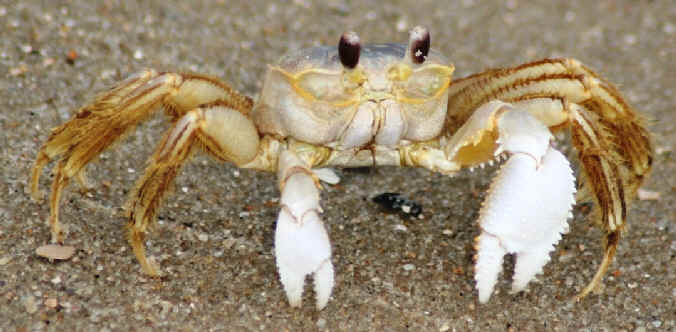
Atlantic Ghost Crab
- Atlantic Sand Fiddler Crab (*) ______
DE FL MD NC VA (ASC:628) (PAS:58)
Uca pugilator
The geographic range for Uca
pugilator, and the following two species, is from Cape Cod to
Texas.
The habitat preferences for the Sand Fiddler Crab (above) and
the Mud Fiddler Crab (below) do overlap somewhat, but as their
names imply, the Mud Fiddler is more common on mudflats, while the Sand
Fiddler is more often found in sandier situations and higher up on the
beach.
Fiddlers are colonial, and active by day. They feed on bacteria,
minute algae, and fermenting marsh plants gleaned from the soil.
They vary in color from tan to brown. Generally, the Sand Fiddler Crab
(above) is a lighter coloration than the other two species (below).
Male Fiddler Crabs (of all 3 species) have an oversized claw on one
side, while female Fiddler Crabs have equal-sized claws. The larger
claw of the male can grow to 2 inches long.
Female Fiddler Crabs feed by rapidly alternating right and left
claws, much like children stuffing candy into their mouths as fast as they
can.
Male Fiddler Crabs eat with just one claw, since their oversized claw
is for courtship behavior and territorial defense - to attract a mate and
discourage rivals, not for fighting predators that can include shorebirds,
raccoons, terrapins, fish, and larger
crabs.
- Atlantic Marsh Fiddler Crab (*)
______ DE FL MD NC VA
(PAS:58)
Uca pugnax
Another name for Uca pugnax
is Mud Fiddler Crab.
The male Marsh Fiddler Crab has a royal blue spot on the center
of its carapace, while the male Sand Fiddler Crab (above) has
a blue or purplish carapace. The carapaces vary from being less than an inch
wide to 1.5 inches.
The Marsh Fiddler Crab is the smallest of the 3 fiddler crabs in this
list, while the Brackish-water, or Red-jointed Fiddler Crab is
the largest.
- Brackish-water Fiddler Crab (*)
______ DE MD NC VA
(ASC:629) (PAS:58)
Uca minax
Another name for Uca minax
is Red-jointed Fiddler Crab.
Burrow openings for Uca minax are
often above water. Those of the other two fiddler crabs are chiefly
intertidal.
Uca minax is the most common of
the 3 species of fiddler crabs in the region of the Chesapeake Bay.
It ranges into the area of the upper Bay, whereas Uca
pugilator and Uca pugnax
are generally restricted to the middle and lower Chesapeake Bay.
As to habitat preference, Uca minax,
the Brackish-water, or Red-jointed Fiddler Crab, and Uca
pugnax. the Marsh Fiddler Crab live in muddy
areas in marshes. As the name "Brackish-water" implies, Uca
minax is more tolerant of low salinity.
Marsh Fiddler Crabs are found between the low and high tide lines,
while the Brackish-water Fiddler Crabs dig their burrows above the
high-tide line. The burrows are one to two feet in
depth.
SPIDER CRABS: in the families OREGONIIDAE,
EPIALTIDAE, and MAJIDAE
- Great Spider Crab
______ (ASC:660,661) (PAS:60) from
the Arctic to Rhode Island
Hyas araneus
Another name for Hyas araneus is Toad
Crab. The species was described by Linnaeus in 1758.
In Iceland, Hyas araneus is
called, in English, the Spider Crab. It is the most common crab
there.
- Red-spotted Spider Crab ______ DE
FL MD NC VA
(PAS:60) Cape Cod to the West Indies
Pelia mutica
The Red-spotted Spider Crab grows up to one-half inch in length. It
is often covered by sponge, and is easily overlooked as it is among sponges,
hydroids, and sea squirts on wharf pilings or among pebbles and shell
fragments in bays and sounds.
- Doubtful Spider
Crab ______ DE FL MD
NC VA
(PAS:60) mainly from Cape Cod to the Gulf of Mexico
Libinia dubia
Another name for Libinia
dubia is Long-nosed Spider Crab. It is said to be more
common in the Common Spider Crab in the Chesapeake Bay, but generally
it is the less common species elsewhere.
- Common Spider Crab
______ DE FL MD NC VA (ASC:656) (PAS:60)
Nova Scotia to the Gulf of Mexico
Libinia emarginata
Another name for Libinia
emarginata is Portly Spider Crab.
- Spiny Spider Crab
______ FL NC (ASC:640)
North Carolina to
the West Indies
Mithrax spinosissimus
DECORATOR CRAB
- Atlantic Decorator
Crab ______ FL NC
North Carolina to the West Indies and Yucatan
Peninsula
Stenocianops furcata
ARROW CRAB
- Arrow Crab
______ FL NC (ASC:574)
North Carolina to
Brazil, including the Wet Indies; also Bermuda
Stenorhynchus seticornis
PARTHENOPIDAE CRABS
- Pourtale's Long-armed
Crab ______ DE FL MD
NC VA Cape Cod to the West Indies
Parthenope pourtalesii
- Saw-toothed Crab
______ FL NC North Carolina to Brazil
Parthenope serrata
ECHINODERMS
(Phyllum Echinodermata)
ASTEROIDS (Class Stelleroidea): including
the sea stars and brittle stars
"Sea Star" is preferred to "Star Fish" as that term is a
misnomer as "fish" are finny vertebrates.
- Banded Luidia ______ FL
NC
(ASC:564) North Carolina to Brazil
Luidia alternata
- Slender Sea Star (or Striped Luidia) ______
DE FL MD NC VA (PAS:63) New
Jersey to Brazil
Luidia clathrata
- Plate-margined Sea Star ______ DE
FL MD NC VA
(PAS:63) New Jersey to Uruguay, but not common north
of Cape Hatteras NC
Astropecten articulatus
- Mud Star ______ (ASC:535)
(PAS:63) from the Arctic to Cape Cod, less common to
North Carolina
Ctenodiscus crispatus
- Cushion Star (ph) ______ FL
NC (ASC:541) North
Carolina to Brazil
Oreaster reticulatus
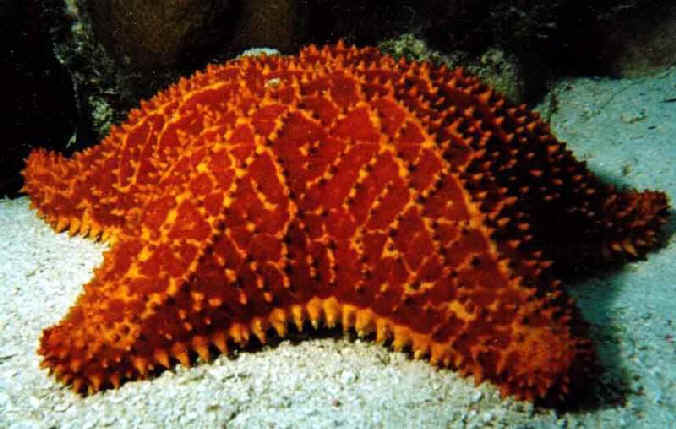
Cushion Star
- Horse Star ______
(ASC:540) from the Arctic to Cape Cod
Hippasteria phrygiana
- Smooth Sun Star ______
(ASC:542,543) from the Arctic to Cape Cod MA, also
North American Pacific coast
Solaster endeca
- Spiny Sun Star ______
(ASC:545) from the Arctic to the Gulf of Maine, also
North American Pacific coast
Crossaster papposus
- Winged Sea Star ______
(ASC:539) from the Arctic to Cape Cod MA
Pteraster militaris
- Badge Sea Star ______
DE MD NC VA
(ASC:538) Cape Cod MA to Cape Hatteras NC
Porania insignis
- Blood Star ______ DE
MD NC VA
(ASC:552) (PAS:63) Circumpolar, south to Cape
Hatteras, NC
Henricia sanguinolenta
- Thorny Sea Star ______ FL
NC
(ASC:549) North Carolina to the West Indies
Echinaster sentus
- Forbes' Common Sea Star (or
Forbes' Asterias) ______ DE
FL MD NC VA
(ASC:557,558) (PAS:63) Maine to the Gulf of Mexico
Asterias forbesi
The Asterias
species are the most familiar sea stars along the Atlantic Coast (of North
America).
Asterias forbesi is a common
species south of Cape Cod.
- Northern Sea Star (or
Boreal Asterias) ______ DE
MD NC VA
(ASC:547,559) (PAS:63) Iceland and Labrador to Cape Hatteras
Asterias rubens
(has been Asterias vulgaris)
The Northern Sea Star
is a common species north of Cape Cod.
Generally, what has been Asterias vulgaris is
intertidal northward. South of Cape Cod, it is subtidal in progressively
deeper water to a depth of 2,000 feet.
In the Long Island Sound, Asterias
sea stars have been a menace on oyster beds.
Sea Stars breed there slightly before oysters, and the infant
sea stars await oyster spat, literally, with their open arms.
They grow rapidly, and their arms may be 3 inches long by the age of 4
months.
The oyster is opened after a tug of war and devoured by the sea
star's everted stomach.
- Green Slender Sea Star ______
from the Arctic to the Gulf of Maine
Leptasterias
littoralis
- Slender Sea Star ______ DE
MD NC VA (ASC:560)
Nova Scotia to Cape Hatteras NC
Leptasterias tenera
- Northern Basket Star ______
(ASC:572) from the Arctic to Cape Cod MA
Gorgonocephalus
articus
- Short-spinned Brittle Star ______
DE FL MD NC VA
(PAS:64) Cape Cod MA to Brazil
Ophioderma brevispina
- Daisy Brittle Star ______ (ASC:570)
(PAS:64) from the Arctic south to Cape Cod, rarely
Long Island; also North American Pacific coast
Ophiopholis aculeata
- Dwarf Brittle Star ______ DE
FL MD NC VA (ASC:568)
(PAS:64) from the Arctic to Florida, also North
American Pacific coast
Axiognathus squamatus
- Atlantic Long-spined Brittle Star ______
FL NC VA
(PAS:64) from the lower Chesapeake Bay (Tangier Sound) to
Brazil
Ophiothrix angulata
SEA URCHINS and SAND DOLLARS (Class
Echinoidea)
- Slate-pencil Urchin ______ FL
(ASC:517) South Carolina to Brazil
Eucidaris tribuloides
- Atlantic Purple Sea Urchin
______ DE FL MD NC VA (ASC:518)
(PAS:62) Cape Cod to Trinidad; in the West Indies and
on the Yucatan Peninsula
Arbacia punctulata
- Variegated Urchin ______ FL
NC
(ASC:521,528) North Carolina to the West Indies
Lytechinus variegatus
- Green Sea Urchin
______ (ASC:523) (PAS:62)
from the Arctic to New Jersey, also North American Pacific coast
Strongylocentrotus droebachiensis
- Brown Sea Biscuit
______ FL NC North
Carolina to Brazil
Clypeaster rosaceus
- Common Sand Dollar (ph) (*) ______
DE MD
(ASC:530) (PAS:62) Labrador to Maryland, also North
American Pacific coast
Echinarachnius parma
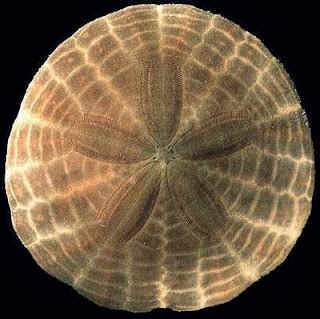
Common Sand Dollar
- Keyhole Urchin (or Keyhole Sand
Dollar) ______ DE
FL MD NC VA
(ASC:534) Cape Cod to Brazil, also Bermuda
Mellita quinquiesperforata
Mellita quinquiesperforata is more closely related to other
sand dollars than to sea urchins.
- Six-hole Urchin ______ FL
(ASC:532) South Carolina to
Uruguay
Mellita sexieperforata
- Mud Heart Urchin ______ FL
NC
(PAS:62) Cape Hatteras NC to the West Indies
Moira atropos
SEA CUCUMBERS
(Class Holothuroidea)
- Scarlet Psolus ______
(ASC:153,155) (PAS:46) from the Arctic to Cape Cod
Psolus fabricii
The Scarlet Psolus can be found
on seashores at low tide, but only in places with extreme tidal fluctuation.
It is a striking creature when fully extended, but appears as a mere red
lump when contracted.
- Hairy Cucumber ______ DE
FL MD NC VA
(ASC:150) (PAS:46) Cape Cod to the Gulf of Mexico
Sclerodactyla
briareus
- Havelockia scabra
______ DE
a rare boreal
species, south to the Delaware Bay
- Orange-footed Sea Cucumber ______
(ASC:152) (PAS:46) from the Arctic to Cape Cod
Cucumaria
frondosa
- Pink Synapta ______
(PAS:46) Bay of Fundy to the Long Island Sound
Leptosynapta
roseola
- White Synapta ______ DE
FL MD NC VA (ASC:260)
along
the entire Atlantic Coast (of North America), also the Pacific Coast, and
Europe
Leptosynapta
tenuis
- Silky Cucumber ______
(ASC:267) (PAS:46) from the Arctic to Cape Cod
Chiridota
laevis
- Rat-tailed Cucumber ______
(PAS:46) Gulf of St. Lawrence to Rhode Island
Caudina arenata
- Molpadia oolitica
______ from Gulf of
Maine southward in deep water
CHORDATES
(Phyllum Chordata)
SEA
SQUIRTS, and
TUNICATES or ASCIDIANS (Class Ascidiacea)
- Northern Sea Pork ______ DE
FL MD NC VA (ASC:98)
Maine to the Gulf of Mexico
Aplidium constellatum
- Common Sea Pork ______ DE
FL MD NC VA (PAS:10)
geographic range similar to that of the previous
species
Aplidium stellatum (was Amaroucium stellatum)
- Sea Vase ______
(ASC:105) (PAS:17) from the Arctic to Cape Cod, also
North American Pacific coast
Ciona
intestinalis
- Callused Sea Squirt ______ from
the Arctic to Cape Cod
Ascidia callosa
Another name for Ascidia callosa
is Callused Tunicate.
- Ascidia prunum
______ confined to
deep water
Ascidia prunum can only be
distinguished from
Ascidia callosa by dissection.
- Blood Drop Sea Squirt ______ (ASC:93)
(PAS:17)
Newfoundland, Canada to Long Island Sound
Dendrodoa
carnea
Another name for Dendrodoa carnea
is Blood Drop Tunicate
- Rough Sea Squirt ______ DE
FL MD NC VA
(PAS:17) Bay of Fundy to the Caribbean
Styela partita
- Striped Tunicate
______ FL NC
(ASC:106,107) North Carolina to the West Indies,
also North American Pacific coast in California
Styela plicata
- Cactus Sea Squirt ______
(ASC:111) (PAS:17) from the Arctic to Cape Cod
Boltenia
echinata
Another name for Boltenia echinata
is Cactus Tunicate.
- Stalked Sea Squirt ______ (ASC:41)
(PAS:17)
from the Arctic to Cape Cod
Boltenia
ovifera
Another name for Boltenia ovifera
is Stalked Tunicate.
- Sea Peach ______
(ASC:92) (PAS:17) from the Arctic to Massachusetts
Bay
Halocynthia
pyriformis
Sea Grapes (PAS:17):
- Bostrichobranchus
pilularis ______ the
whole North American Atlantic Coast, but rare south of Cape Cod
- Molgula arenata
______ Bay of Fundy
to Cape May
- Common Sea Grape ______ DE
FL MD NC VA
Bay of Fundy
to the Gulf of Mexico
Molgula manhattensis
- Molgula provisionalis
______ Maine
northward
- Orange Sea Grape
______ (ASC:97)
Gulf of St.
Lawrence to Cape Cod
Molgula citrina
- Molgula siphonalis
______ from the
Arctic to Maine
- Molgula retortiformis
______ from the
Arctic to Cape Cod
White Crusts (PAS:10):
- Glossy White Crust
______ DE FL MD NC VA
Bay of Fundy to Brazil
Didemnum candidum
The boreal and tropical forms of Didemnum
candidum may not be the same species.
- Northern White
Crust ______ (ASC:125) from the Arctic to Cape Cod
Didemnum albidum
- Lissoclinum aureum
______ from the Arctic to Cape Cod
Lissoclinum aureum is generally in
deep water except at the northern limit of its range.
- Golden Star Tunicate ______ DE
MD NC VA
(ASC:121) (PAS:10) from the Bay of Fundy to North
Carolina
Botryllus schlosseri
- Mushroom Tunicate
______ FL (ASC:91)
South Carolina to the West Indies and
Colombia
Distaplia stylifera
- Sandy-lobed Amaroucium ______
DE FL MD NC VA
(PAS:10) Cape Cod to the Gulf of Mexico
Amaroucium pellucidum
- Creeping Tunicate ______ DE
FL MD NC VA (ASC:101)
Cape Cod to Florida and Texas
Perophora viridis
Another name for
Perophora viridis
is Creeping Ascidian.
- Orange Sheath
Tunicates ______ DE FL
MD NC VA (ASC:119)
Atlantic and Pacific
coasts of North America
Botrylloides spp.
PELAGIC TUNICATES, SALPS (Class Thaliacea)
- Common Doliolid
______ DE FL MD NC VA
(ASC:489) Cape Cod MA to tropical South America
Doliolum nationalis
Common Doliolids are transparent creatures that are sometimes blown ashore
by the thousands in summer and autumn.
- Horned Salp
______ DE FL MD NC VA
(ASC:490) Cape Cod MA to tropical South
America
Thalia democratica
- Common Salp
______ DE FL MD NC VA
(ASC:488) the entire Atlantic coast
Salpa fusiformis
LANCELET (Class Leptocardii)
- Caribbean Lancelet
______ FL MD NC VA
Chesapeake Bay to the West Indies
Branchiostoma caribaeum
BRACHIOPODS (Phyllum
Brachiopoda)
The Phyllum
BRACHIOPODA includes, worldwide, about 280 living species of shelled
animals, but over 30,000 fossil species have been described
from as far back as 600 million years ago.
The BRACHIOPOD SHELL consists of 2 valves and superficially resembles that
of the BIVALVE MOLLUSKS (earlier in this list).
But unlike those of MOLLUSKS, the valves of the BRACHIOPODS are upper
and lower instead of left and right.
- Green-banded
Brachiopod ______ FL NC North Carolina to Texas
Glottidea pyramidata
- Northern Lampshell
______ (ASC:358) Labrador to New Jersey
Terebratulina septentrionalis
PLANT-LIKE
ANIMALS: BRYOZOANS (Phyllum Bryozoa)
- Rubbery Bryozoan
______ (ASC:49) from the Arctic to Long Island Sound
Alcyonidium hirsutum
- Pussley Bryozoan
______ DE MD VA Cape Cod MA to the Chesapeake Bay
Alcyonidium verrilli
- Porcupine Bryozoan
______ (ASC:34) from the Arctic to Long Island Sound
Flustrellidra hispida
- Bowerbank's Graceful
Bryozoan ______ DE FL MD
NC VA Maine to Florida, also North American
Pacific coast
Bowerbankia gracilis
- Bowerbank's Imbricated
Bryozoan ______ DE FL MD
NC VA Massachusetts to Florida
Bowerbankia imbricata
- Articulated Bryozoan
______ DE FL MD NC VA
(ASC:65) Labrador to the West Indies
Crisia spp.
- Bushy Twinned Bryozoan
______ (ASC:76) from the Arctic to Cape Cod MA
Eucratea loricata
- Hairy Bryozoan
______ (ASC:113) from the Arctic to Long Island Sound
Electra pilosa
- Sea Lichen Bryozoan
______ (ASC:48) from the Arctic to Martha's Vineyard
MA
Dendrobeania murrayana
- Spiral-tufted Bryozoan
______ DE FL MD NC VA
(ASC:73) Massachusetts to Florida
Bugula turrita
- Ellis' Bryozoan
______ (ASC:47) from the Arctic to Cape Cod MA
Caberea ellisii
- Single-horn Bryozoan
______ DE FL MD NC VA
(ASC:117) from the Arctic to Florida
Schizoporella unicornis
- Staghorn Bryozoan
______ FL NC North Carolina to the West Indies
Schizoporella floridana
- Common Red Crust
Bryozoan ______ DE FL MD
NC VA (ASC:114) Nova Scotia to Florida
Cryptosula pallasiana
References include:
"Sea Life - A Complete Guide to the Marine Environment", edited by
Geoffrey Waller, with principal contributors Marc Dando & Michael Burchett,
1996.
To Top of
Page



 MARINE LIFE
MARINE LIFE![]()

















![]()
![]()















